
by Lorato | Oct 9, 2025 | All News, SMU Media, Student Media
In the world of dentistry, clarity, precision, and confidence are not only professional hallmarks but also the essence of a remarkable personal journey. Few stories illustrate this better than that of Dr Palesa Gwendoline Xolisile Shabalala, an alumna of Sefako Makgatho Health Sciences University (SMU), who rose from early academic struggles to become South Africa’s first KwaMbewunye-born orthodontist sponsored by the KwaZulu-Natal Department of Health.
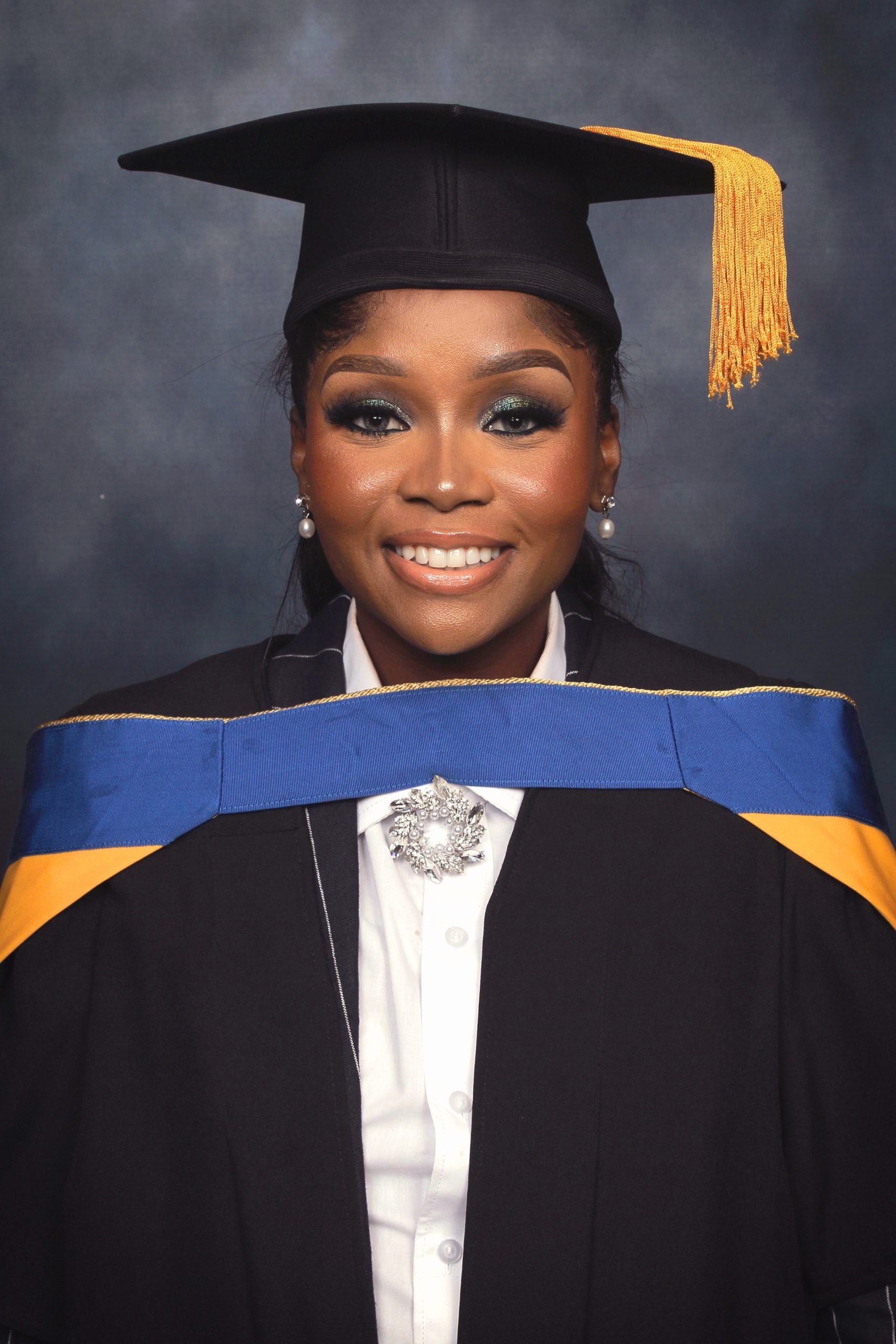 Her path began in Grade 7, when a teacher asked her class to write down their future ambitions and bury them for the future. At the time, Dr Shabalala was academically challenged, particularly in Mathematics, and often misunderstood. Yet, she boldly wrote that she would one day be a doctor. It was not a carefully considered choice, but rather a challenge to herself and to God. Years later, her father encouraged her towards dentistry — a decision that evolved from a profession into a calling. While still at university, she even declared to friends that she would one day become an orthodontist, a bold vision that later became reality.
Her path began in Grade 7, when a teacher asked her class to write down their future ambitions and bury them for the future. At the time, Dr Shabalala was academically challenged, particularly in Mathematics, and often misunderstood. Yet, she boldly wrote that she would one day be a doctor. It was not a carefully considered choice, but rather a challenge to herself and to God. Years later, her father encouraged her towards dentistry — a decision that evolved from a profession into a calling. While still at university, she even declared to friends that she would one day become an orthodontist, a bold vision that later became reality.
Her resolve was strengthened while reading Paulo Coelho’s The Alchemist, where she wrote in the margin: I AM an Orthodontist. She believes that declaration was divinely affirmed. But her motivation came from more than faith; it was rooted in empathy. Having experienced rejection herself, she recognised orthodontics as a way to restore confidence and dignity in others. “A smile is the most expensive commodity,” she explains. “Imagine a life without one.”
In 2018, while pursuing a Master of Business Administration (MBA), Shabalala was sent an advert for the Master of Dentistry in Orthodontics at SMU through a Memorandum of Agreement (MOA) with the KZN Department of Health. She applied on the very last day, thinking she was only accompanying candidates who had been preparing for years. Instead, she became KZN(KwaMbewunye’s) first orthodontist to receive sponsorship for the programme. The experience was anything but easy. “Speciality crushed me. I went through the fire and emerged as a phoenix,” she recalls. The demanding programme tested her patience and resilience, qualities she admits were not naturally her strengths.
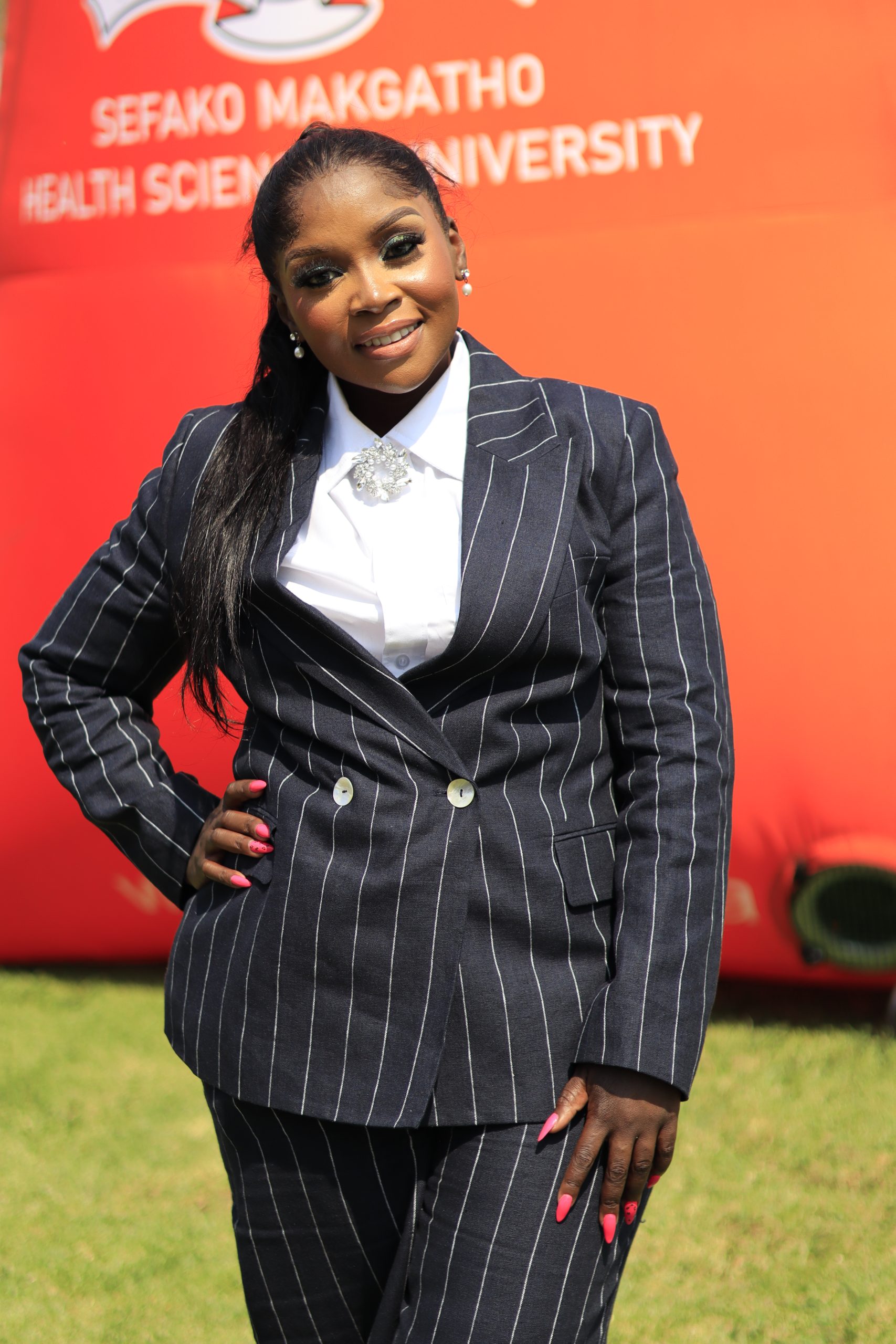 As a supernumerary candidate, she often faced exclusion and bias, but she also encountered God given mentors who guided her through the challenges. Among them were Prof Robert Ndou, Prof Harold Majana, Dr Maurine Dikeledi Letsholo, Dr Solly Nkhumeleni and Prof Sonia Boy, whose support reinforced the importance of perseverance, integrity, and grace under pressure.
As a supernumerary candidate, she often faced exclusion and bias, but she also encountered God given mentors who guided her through the challenges. Among them were Prof Robert Ndou, Prof Harold Majana, Dr Maurine Dikeledi Letsholo, Dr Solly Nkhumeleni and Prof Sonia Boy, whose support reinforced the importance of perseverance, integrity, and grace under pressure.
Her research focused on retained primary teeth — baby teeth that persist into adulthood. While commonly overlooked as a cosmetic issue, she demonstrated its broader effects on bite, jaw health, and treatment planning. Her work highlighted the importance of early diagnosis and preventative dentistry, offering insights not only for clinicians but also for shaping public oral health policy in South Africa.
Looking ahead, Shabalala aspires to establish a multidisciplinary orthodontic centre that serves both as a treatment hub and a space for research and innovation. She is particularly passionate about exploring the connections between oral health, self-esteem, and mental well-being, as well as contributing to the management of temporomandibular disorders.
Her advice to aspiring specialists is clear and uncompromising: “Specialise for love, not prestige. Orthodontics demands skill, resilience, and heart. But the reward is unmatched — transforming lives one smile at a time.”
Shabalala’s journey demonstrates that conviction and courage can turn even the most uncertain beginnings into extraordinary legacies.
By Tumelo Moila
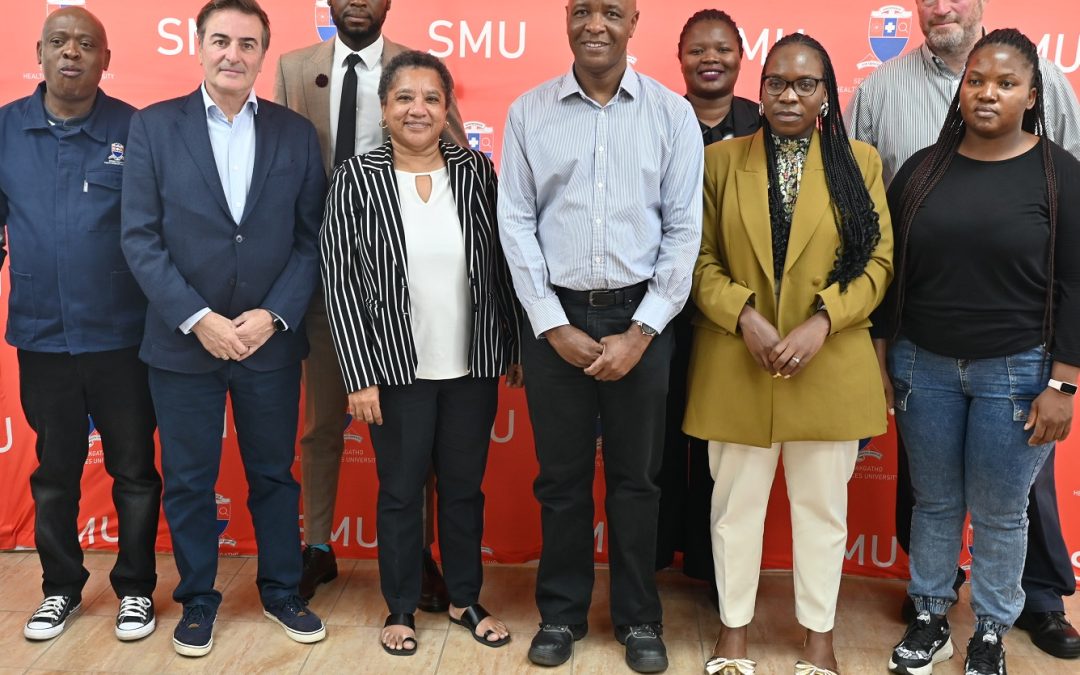
by Lorato | Oct 9, 2025 | Accolades and Achievements, All News, SMU Media, Student Media
Sefako Makgatho Health Sciences University (SMU) has officially embarked on a major sustainability initiative with the launch of a feasibility study to develop a solar generation plant with storage capabilities. The kick-off meeting was held on 12 September 2025, marking the start of a collaborative process that could reshape how the University powers its operations in the years to come.
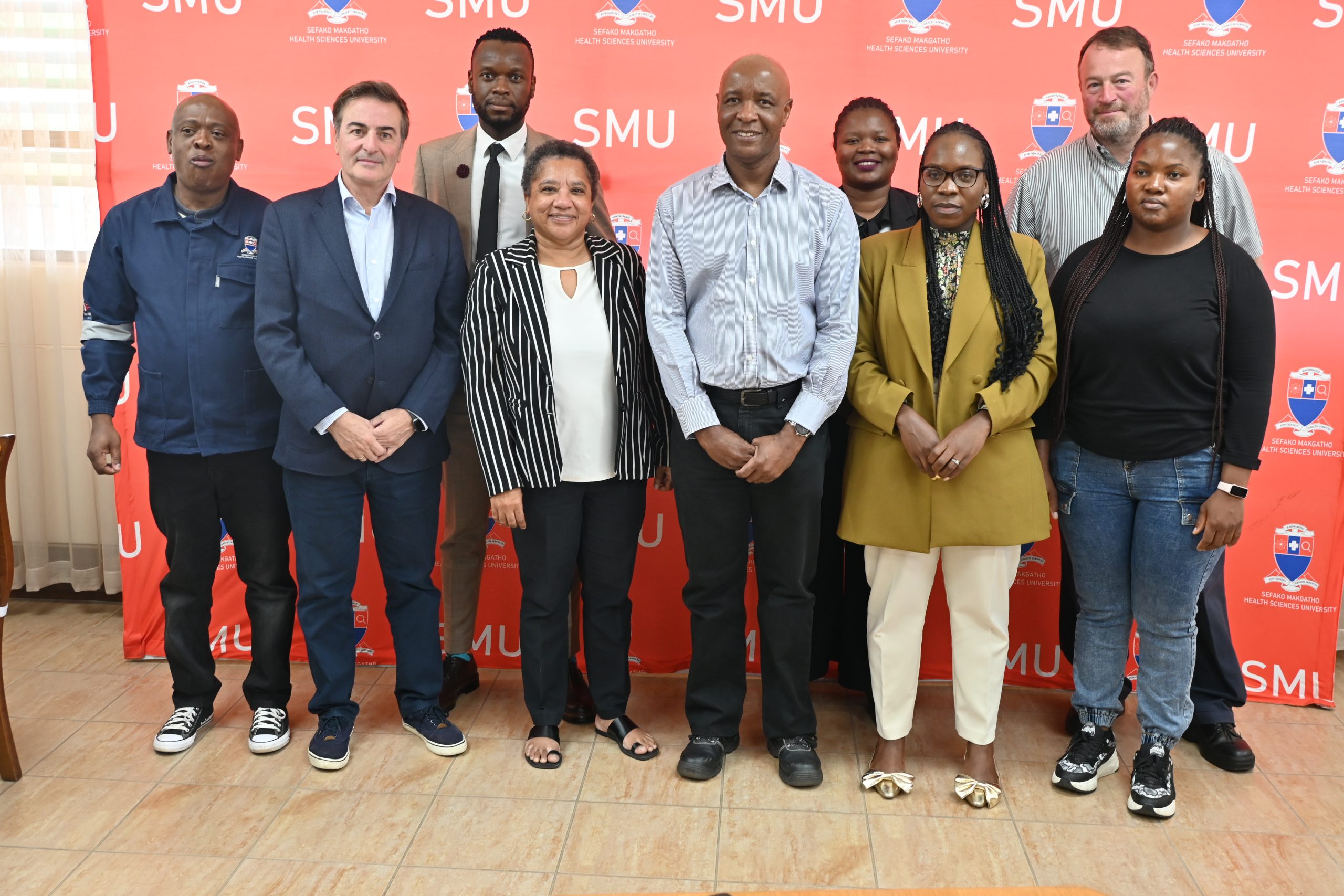 The study is being led by MAI Group, an international consulting and engineering firm, headquartered in Spain, in partnership with Erinite Energy, a South African renewable energy company. Together, they bring world-class expertise and local insight to one of SMU’s most ambitious infrastructure projects to date.
The study is being led by MAI Group, an international consulting and engineering firm, headquartered in Spain, in partnership with Erinite Energy, a South African renewable energy company. Together, they bring world-class expertise and local insight to one of SMU’s most ambitious infrastructure projects to date.
Speaking at the launch, Mr Rafael Somoza, Director at MAI Group, expressed enthusiasm about working with SMU to chart a new energy path for the institution. “This project represents more than just a technical study,” he said. “It’s about helping SMU take a decisive step toward energy independence, sustainability, new revenue from the sale of excess power and long-term resilience. We are honoured to bring our global experience to support the University’s vision.”
MAI Group has more than 25 years of experience and a track record of over 4,500 energy, water and environmental projects in 145 countries. The company is known for its deep technical expertise in renewable energy systems, including solar, wind, hybrid solutions and storage technologies. Its involvement ensures that SMU will receive a comprehensive, data-driven feasibility study that meets international standards.
The local partner, Erinite Energy, is represented by Mr Thomas Makore, the lead for the local team. He highlighted the importance of the partnership, saying, “As a proudly South African company, we are excited to work with SMU to develop solutions that are not only technically sound but also well suited to the local context. This project has the potential to serve as a model for other institutions in the country.”
The Economic and Trade Counsellor of Spain in South Africa, Ms Ana Maria Martinez Jerez, visited SMU in 2023 as part of her familiarisation visit to understand the needs of SMU with respect to infrastructure. The feasibility study is funded through a non-reimbursable grant from the Spanish Government, through the Financial Fund for the Internationalisation of Enterprises (FIEM), which underscores the project’s strategic importance. Its primary output will be a comprehensive and actionable plan that provides the technical details, financial analysis and implementation roadmap required to move the project from concept to implementation. Once completed, the study will give potential funders and developers the confidence to proceed directly to construction and operation of the Solar Photo Voltaic plant with storage.
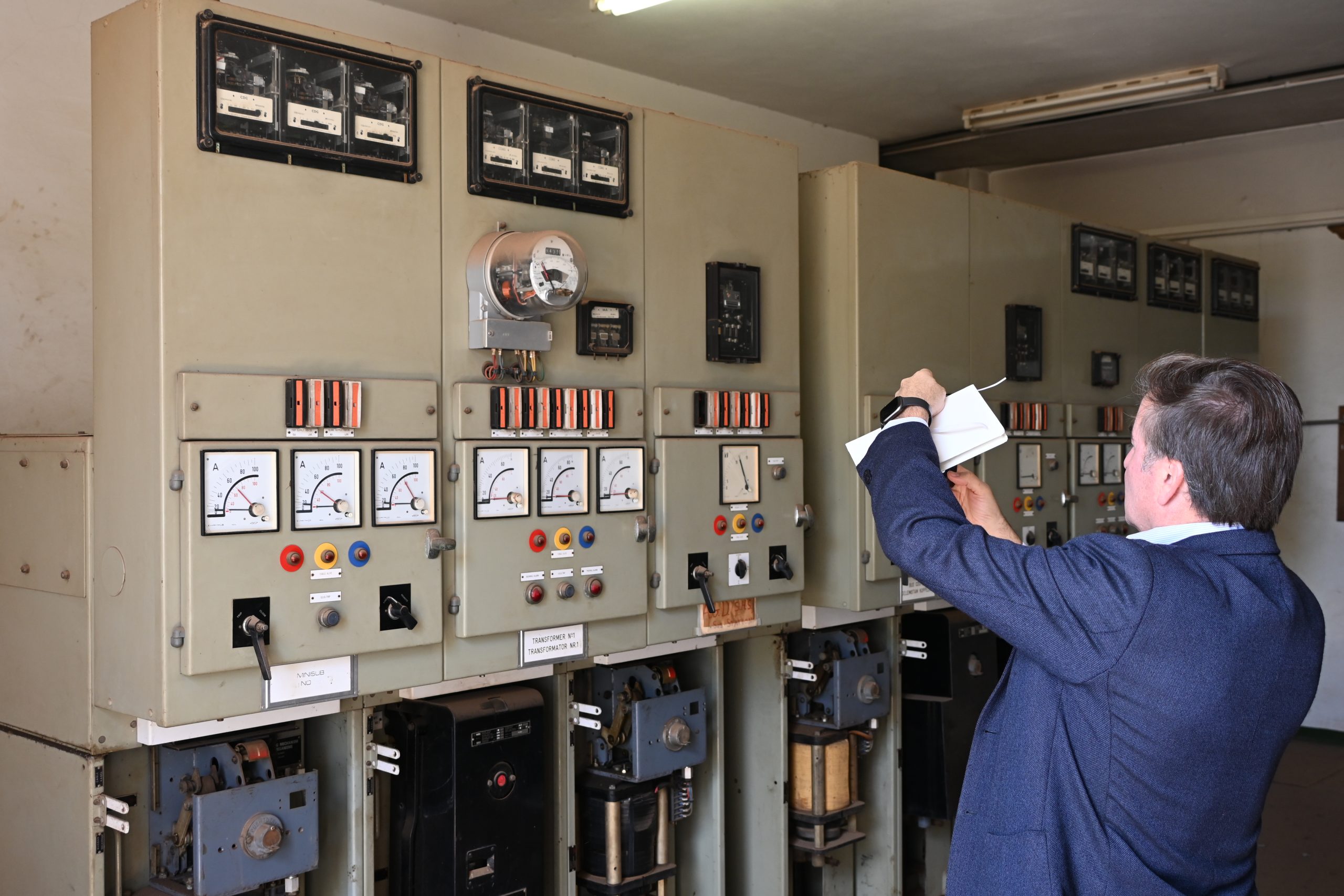 The kick-off meeting was also attended by Ms Odette Ramsingh, Acting Deputy Vice-Chancellor: Operations, whose presence highlighted SMU’s high-level institutional commitment to the initiative. Her involvement ensures that the project is fully aligned with the University’s operational priorities, third stream income objectives and strategic sustainability goals.
The kick-off meeting was also attended by Ms Odette Ramsingh, Acting Deputy Vice-Chancellor: Operations, whose presence highlighted SMU’s high-level institutional commitment to the initiative. Her involvement ensures that the project is fully aligned with the University’s operational priorities, third stream income objectives and strategic sustainability goals.
As part of the project’s early activities, the MAI Group and Erinite Energy teams conducted a detailed site visit to familiarise themselves with SMU’s infrastructure and energy systems. They were accompanied by a team from SMU including Mr Alfred Makgatho, Acting Director: Built Environment, who is playing a key role in coordinating the University’s input. Reflecting on the visit, Makgatho said, “This project comes at a critical time for the University. Reliable and sustainable energy is no longer optional—it’s essential for ensuring the smooth running of academic, clinical and research activities. We are fully committed to supporting this feasibility process so that we can make informed decisions about our energy future.”
Over the next 20 weeks, the study will cover technical, financial, regulatory, environmental and social dimensions, culminating in a final report that will guide SMU’s decision-making. Close collaboration between the University and the project partners will be essential to meet this timeline, particularly in providing accurate data and prompt feedback.
Sefako Makgatho Health Sciences University’s partnership with MAI Group and Erinite Energy marks a decisive step toward a more sustainable energy model. By exploring the development of its own renewable power plant, the University is not only seeking to reduce costs, secure its energy supply and to generate third stream income, but also to contribute to South Africa’s broader transition to cleaner energy and the United Nations Sustainable Development Goals.
As Somoza noted during the launch, “The journey toward renewable energy is both visionary and practical. It requires commitment, collaboration and clear planning. SMU is demonstrating all three, and we are proud to be part of this milestone.”
By Dimakatso Modise
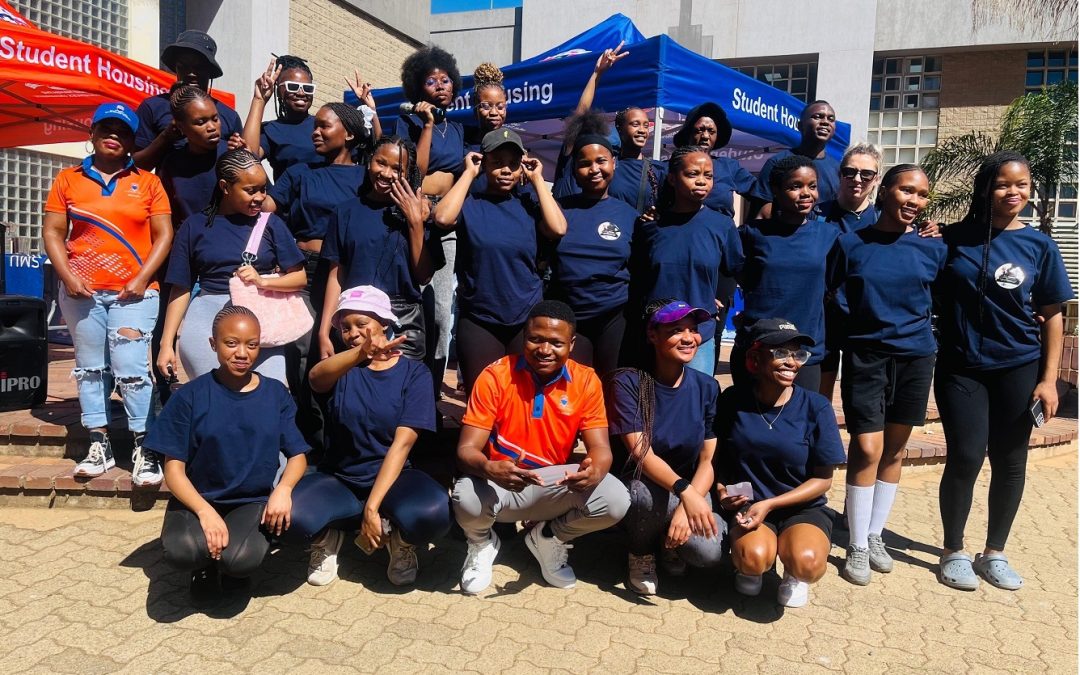
by Lorato | Oct 9, 2025 | All News, SMU Media, Student Media
The campus of Sefako Makgatho Health Sciences University (SMU) recently came alive with colour, energy and purpose as third-year Dietetics students hosted their annual Spring to Wellness campaign. Guided by the slogan ‘Colour Your Plate, Power Your Day’, the initiative sought to inspire both students and staff to embrace holistic wellness through nutrition, physical activity, mental health awareness and sustainable living.
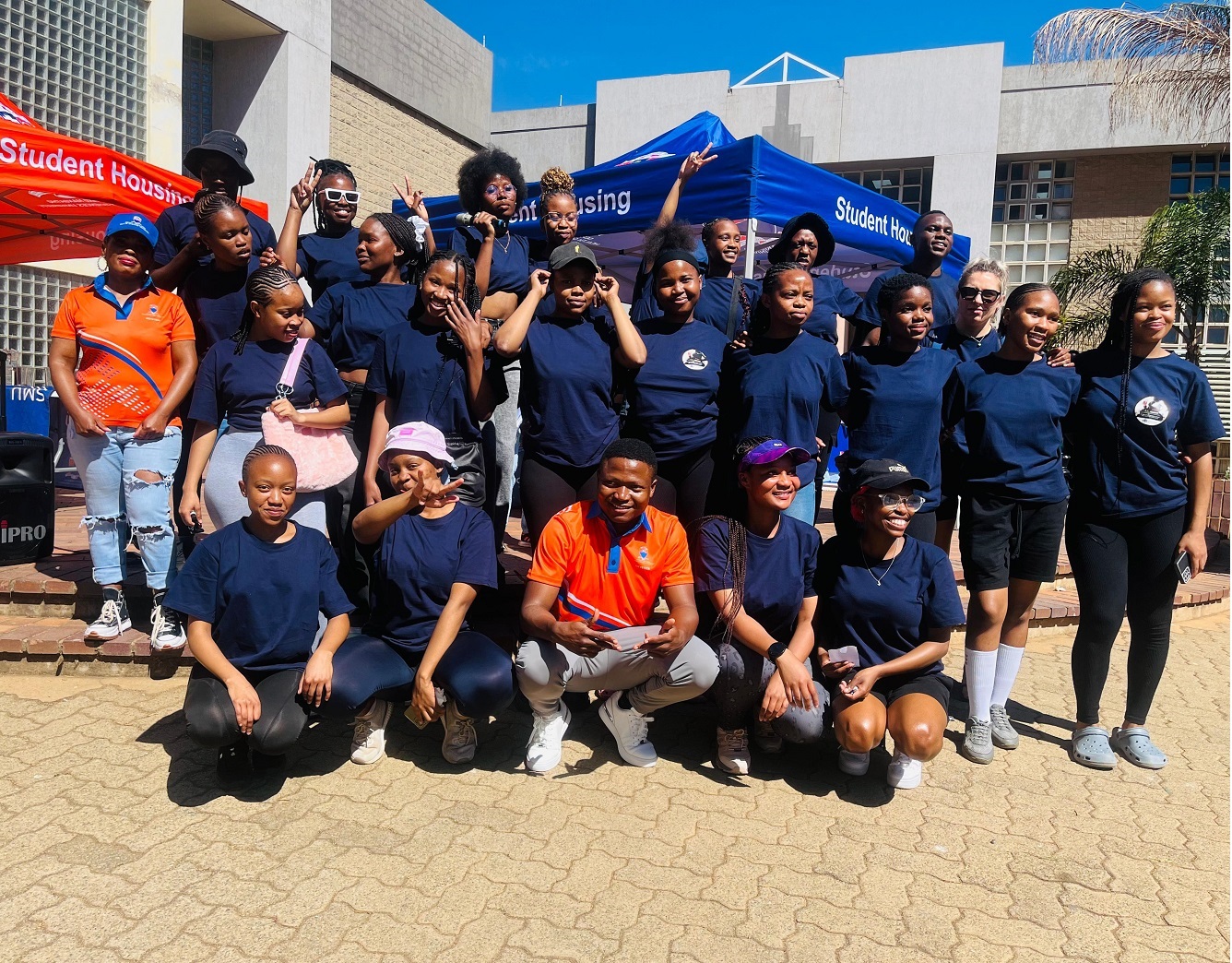 The campaign was chaired by Dietetics student Lebogang Alison Mathe, supported by a team comprising Thabelo Tshikhudo (Secretary), Noluthando Nsele (Media Officer), and treasurers Tebogo Mathiane and Risana Vusi Malebele. Together, they mobilised fellow students and university departments to create a vibrant, campus-wide culture of wellness.
The campaign was chaired by Dietetics student Lebogang Alison Mathe, supported by a team comprising Thabelo Tshikhudo (Secretary), Noluthando Nsele (Media Officer), and treasurers Tebogo Mathiane and Risana Vusi Malebele. Together, they mobilised fellow students and university departments to create a vibrant, campus-wide culture of wellness.
At the heart of the campaign was the conviction that health begins on the plate. “Eating well is like giving your body its own box of crayons – only tastier,” said Chairperson Mathe. “When we colour our plates with spinach, carrots and tomatoes, we are not just eating – we are investing in our health and our future.”
Interactive stalls provided nutritional advice, weight and height assessments, and demonstrations on preparing balanced meals on a student budget. The slogan ‘Colour Your Plate’ was brought to life with practical tips on incorporating affordable, nutrient-dense foods into everyday diets.
The campaign also addressed mental health, physical activity, nutrition and environmental wellness. Nutrition education sessions highlighted how balanced meals rich in wholegrains, fruit, vegetables, lean proteins, and healthy fats can positively influence mood, concentration and resilience to stress. “We want to normalise conversations about mental health at the university, including the role of diet. What you eat affects how you feel – nourishing your body helps nourish your mind. It is okay to admit when you are struggling. Seeking support, emotional or nutritional, is a strength, not a weakness,” said Secretary Tshikhudo.
Physical wellness was promoted through aerobic sessions led by MBChB student Freddy Kunene, alongside yoga and walking activities. “Wellness is not about being an athlete; it is about moving your body in ways that feel good and sustainable,” Kunene explained.
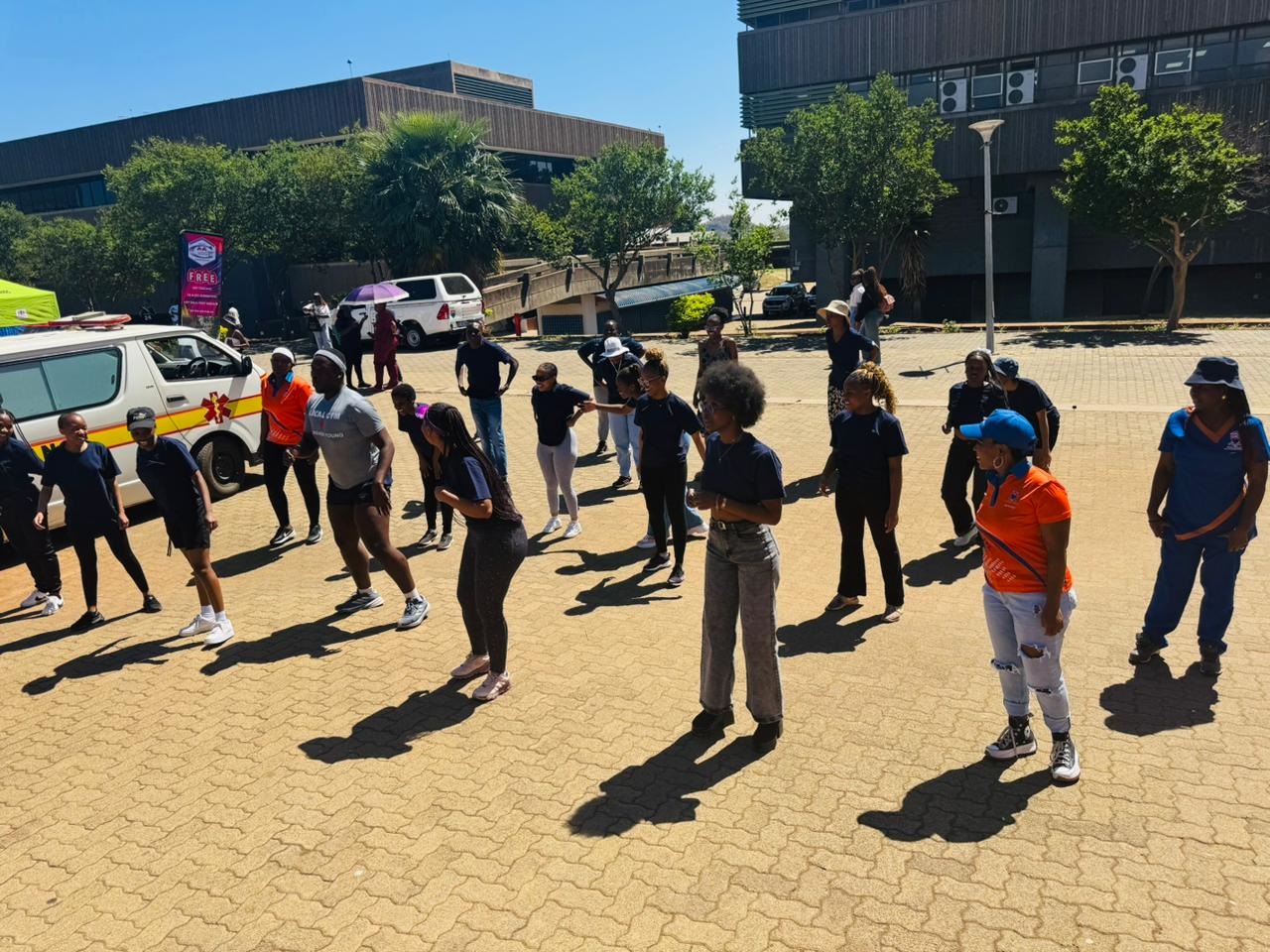 The Department of Built Environment also contributed, emphasising the link between sustainability and health. “A cleaner and greener campus improves mental clarity, reduces stress and supports healthy lifestyles. Protecting our environment means protecting ourselves,” said Dietetics student and representative Amanda Mashabela.
The Department of Built Environment also contributed, emphasising the link between sustainability and health. “A cleaner and greener campus improves mental clarity, reduces stress and supports healthy lifestyles. Protecting our environment means protecting ourselves,” said Dietetics student and representative Amanda Mashabela.
The success of Spring to Wellness lay in its inclusivity. Staff members were actively involved through talks on workplace wellbeing and work–life balance, facilitated by Human Resources. “This campaign reminded us that wellness is everyone’s responsibility – from students to staff. We all play a role in creating a healthier SMU,” said Nsele, Media Officer.
Feedback from participants revealed greater awareness of wellness practices and renewed motivation to live healthier lives. For Dietetics students, the campaign also offered valuable hands-on experience in leadership, teamwork and communication.
“This is more than a once-off event. We want wellness to be part of SMU’s DNA. Every small change – a piece of fruit, a short walk or a moment of mindfulness – adds up to healthier, happier lives,” said Mathe.
By uniting nutrition, mental health, fitness and sustainability, Spring to Wellness delivered a clear message: holistic wellness is both achievable and essential. As participants left with colourful plates, brighter smiles and renewed motivation, the campaign demonstrated a shared commitment to shaping a healthier, more resilient SMU community.
By Tumelo Moila
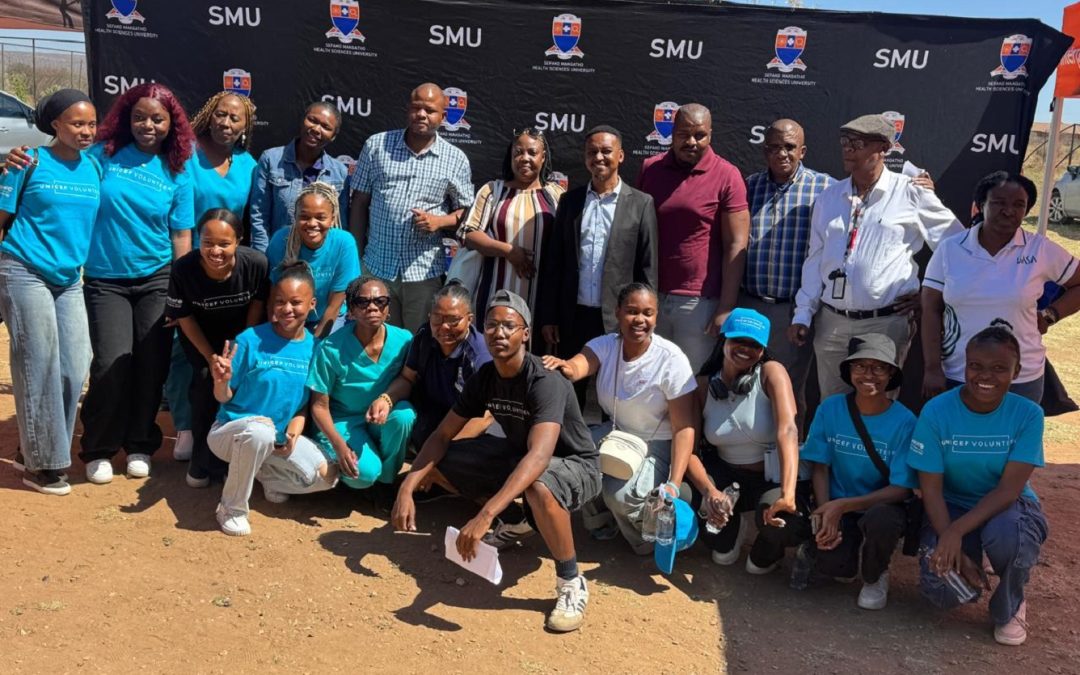
by Lorato | Oct 9, 2025 | All News, SMU Media, Student Media
Sefako Makgatho Health Sciences University (SMU) has once again demonstrated the power of interprofessional collaboration by partnering with Diphetogo Senior Secondary School in Winterveldt, north of Tshwane. This ongoing Interprofessional Community Engagement (CE) partnership blended environmental action, health promotion, literacy development, and youth empowerment.
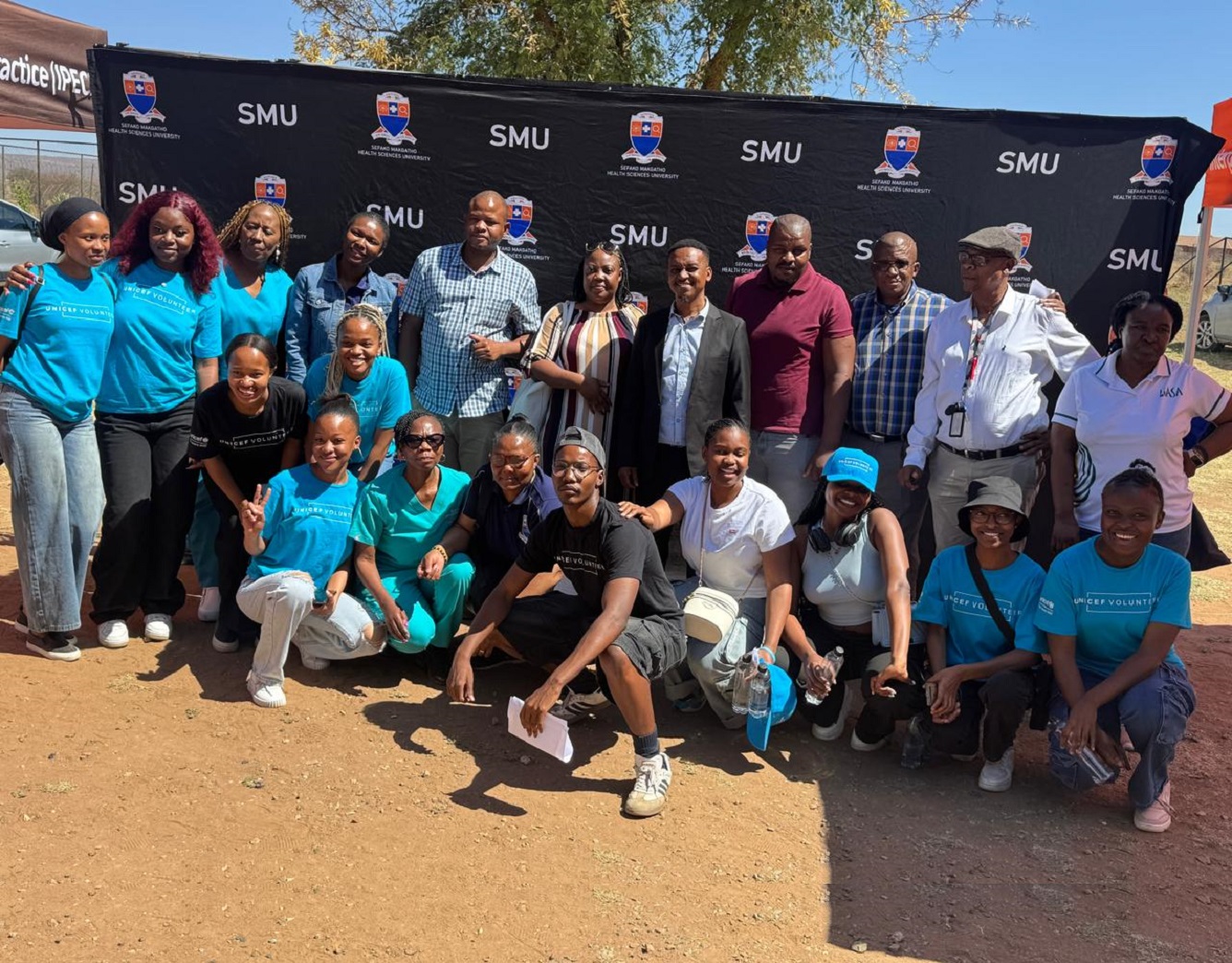 This was no ceremonial visit — it is a working partnership. Teams from SMU’s Departments of Biology and Environmental Sciences, Occupational Health and Safety, Academic Literacy, Library and Information Services, Physiotherapy, Built Environment (Horticulture), and the Interprofessional Education and Collaborative Practice (IPECP) Unit came together with one goal: to deliver practical, lasting impact.
This was no ceremonial visit — it is a working partnership. Teams from SMU’s Departments of Biology and Environmental Sciences, Occupational Health and Safety, Academic Literacy, Library and Information Services, Physiotherapy, Built Environment (Horticulture), and the Interprofessional Education and Collaborative Practice (IPECP) Unit came together with one goal: to deliver practical, lasting impact.
“This engagement was about turning promises into action,” said the school representative, Sipho Nkopane, in his opening remarks. “SMU has shown that collaboration can strengthen our learners’ education and wellbeing in ways that go beyond the classroom.”
The initiative built on the first SMU–Diphetogo collaboration and honoured commitments made during the initial engagement, while equipping learners with practical skills in health, environmental stewardship, and literacy. At its heart, it sought to strengthen the school–university partnership through shared responsibility.
Led by SMU’s horticulturist Mpho Mmako, learners and staff planted ten indigenous trees under the theme Friendship, Health, and Agroforestry. Trees such as Celtis africana and Combretum erythrophyllum now line the school grounds, alongside demonstrations of bottled-water irrigation techniques. “We wanted learners to see that even small innovations can save water and protect our natural environment,” said Mmako.
The Biology and Environmental Sciences team conducted hands-on workshops in waste management, recycling, and composting. “It wasn’t about theory. We wanted learners to leave knowing exactly what to do at home and at school — from managing waste responsibly to composting and recycling,” explained Atlegang Leeuw, a third-year Environmental Sciences student.
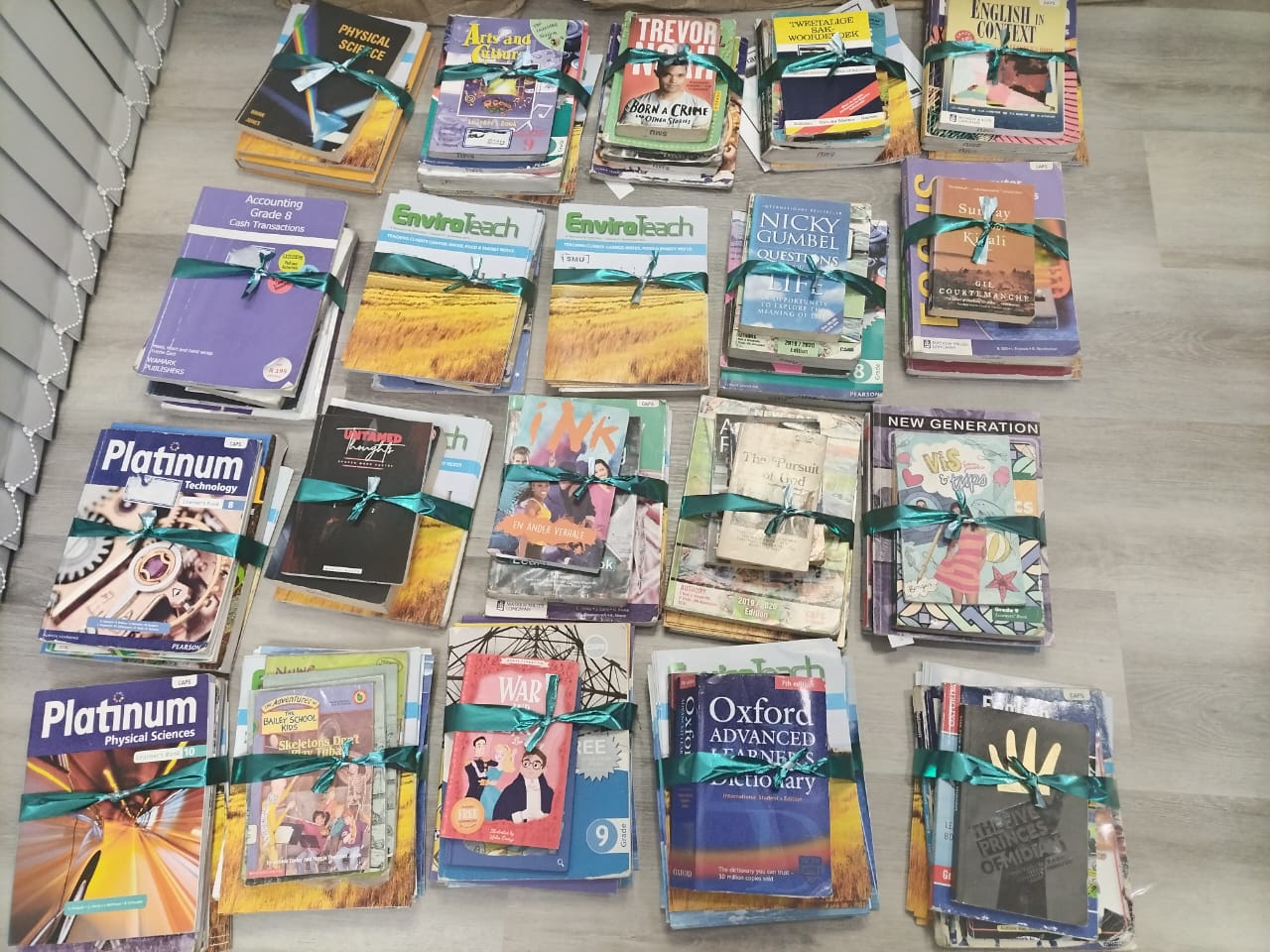 Literacy was another key focus. The Library and Information Services team launched the school’s library with books donated through a successful book drive and newly purchased titles. Learners read aloud, took part in language activities, and shared stories with their peers. The Academic Literacy Unit reinforced the message with the Setswana proverb “Lekau le sa eteng, le nyala kgaitsadi-a-lona” — meaning he who never travels ends up marrying his cousin. “Reading takes you places you might never reach physically. It broadens horizons and inoculates the mind against ignorance,” said Mmakgoshi Reetseng, Senior Librarian and event liaison officer.
Literacy was another key focus. The Library and Information Services team launched the school’s library with books donated through a successful book drive and newly purchased titles. Learners read aloud, took part in language activities, and shared stories with their peers. The Academic Literacy Unit reinforced the message with the Setswana proverb “Lekau le sa eteng, le nyala kgaitsadi-a-lona” — meaning he who never travels ends up marrying his cousin. “Reading takes you places you might never reach physically. It broadens horizons and inoculates the mind against ignorance,” said Mmakgoshi Reetseng, Senior Librarian and event liaison officer.
Health and wellness were highlighted by the Physiotherapy Department, whose activities aligned with World Physiotherapy Month’s theme of Healthy Ageing and Physical Activity. Learners received skipping ropes and three new drum sets for the school’s majorette project. “Movement is medicine,” said Ntombenkosi Sobantu, a physiotherapy lecturer, before joining learners in group exercises and drum-led choreography that filled the schoolyard with energy and laughter.
Behind the scenes, the IPECP Unit coordinated logistics, transport, gazebos, and refreshments. They also recognised learners who showed courage by reading aloud before their peers. “Our role is to make collaboration possible,” said Thokozile Kgongwana, IPECP Coordinator. “When departments come together like this, the impact is multiplied.”
By the end of the day, learners had acquired new skills in environmental care, celebrated the opening of their library, and embraced physical activity with renewed enthusiasm. The partnership left behind more than trees, books, and equipment — it strengthened the bond between the school and the university.
“This was not a once-off outreach,” said Sobantu. “It is proof that universities can step outside lecture halls to change lives.” As learners danced to South African music, drums beating in rhythm with their new confidence, the message was unmistakable: collaboration works.
The Diphetogo Senior Secondary School management and board members witnessed first-hand how academic excellence, community partnership, and practical action can cultivate knowledge, health, and environmental awareness — together.
By Tumelo Moila
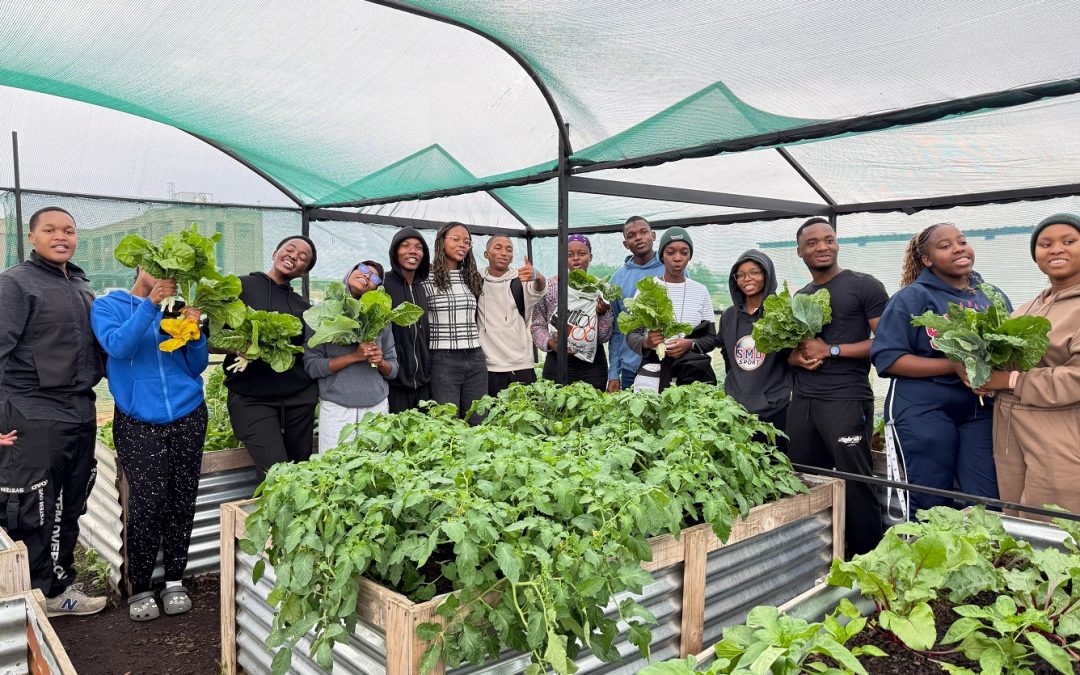
by Lorato | Oct 9, 2025 | All News, SMU Media, Student Media
Sefako Makgatho Health Sciences University (SMU) has breathed new life into its Interprofessional Garden through the Green Campus Initiative (GCI), officially relaunched on 20 August 2025 under the theme “ReRoot – Growing Sustainability, Health, and Collaboration.” The event united students, staff, and partners in a shared vision of environmental stewardship, food security, and holistic well-being.
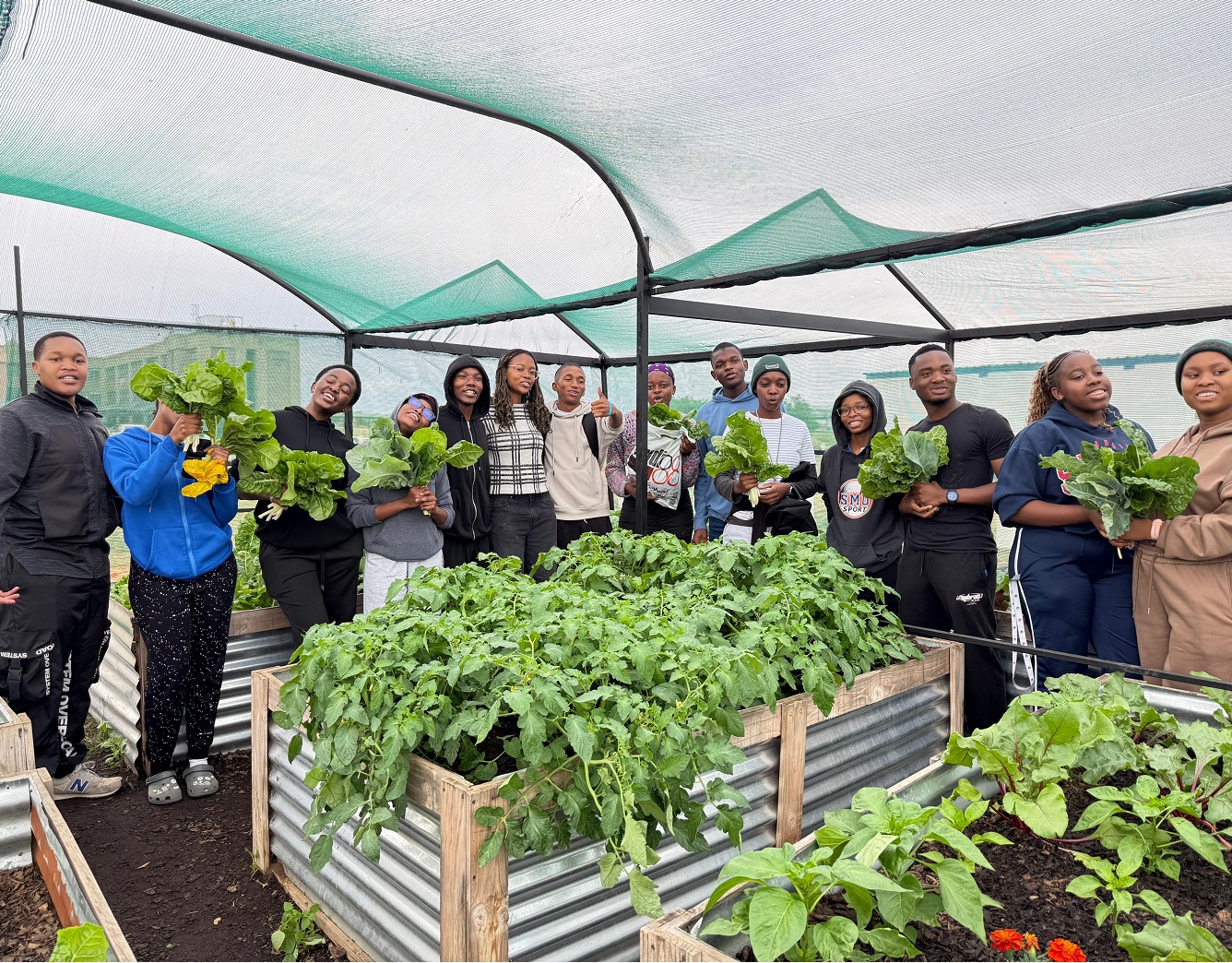 From the moment guests arrived, the energy was purposeful. The Green Welcome set the tone for an afternoon rooted in action and collaboration. Opening the programme, GCI Chairperson Atlegang Leeuw called for student-led accountability in sustainability efforts. “Sustainability starts with us,” she said. “As future health professionals, we have a duty to create a healthier environment for generations to come.”
From the moment guests arrived, the energy was purposeful. The Green Welcome set the tone for an afternoon rooted in action and collaboration. Opening the programme, GCI Chairperson Atlegang Leeuw called for student-led accountability in sustainability efforts. “Sustainability starts with us,” she said. “As future health professionals, we have a duty to create a healthier environment for generations to come.”
Interprofessional Education and Collaborative Practice (IPECP) Coordinator Thokozile Kgongwana reinforced this call, highlighting that environmental change depends on unity across disciplines. “The garden shows what’s possible when faculties and students work together,” she said. “Collaboration is where real impact begins.”
Garden Supervisor Mpho Mmako guided participants through an interactive tour, recounting how the initiative had grown from a modest idea into a “living classroom” blending science, health, and community. “Our goal is simple,” she said. “We want to cultivate learning while nurturing food security and environmental awareness.”
The City of Tshwane’s representative, Kamogelo Aphane, underscored the importance of partnerships. “When institutions and communities work hand in hand, change multiplies,” he said. “Projects like this garden show how collaboration can build sustainable futures.”
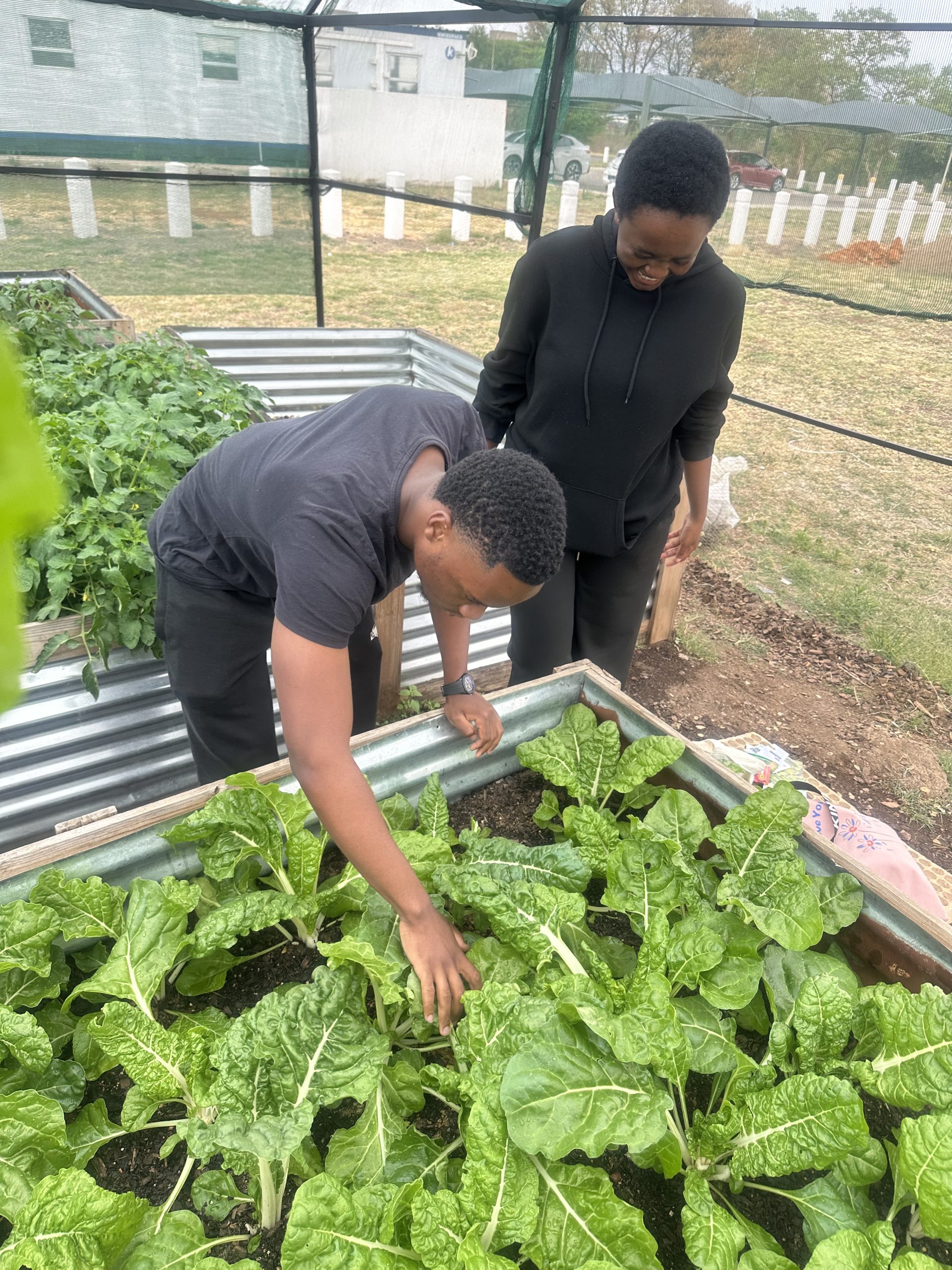 To deepen engagement, the municipality invited students to complete a sustainability questionnaire, offering prizes that sparked discussion on local environmental issues and everyday action.
To deepen engagement, the municipality invited students to complete a sustainability questionnaire, offering prizes that sparked discussion on local environmental issues and everyday action.
Adding a motivational spark, Miss Earth South Africa 2nd Runner-up and Ms Water titleholder Tshiamo Morare reminded participants of the collective power of small actions. “Every tree planted, every sustainable choice—each one adds up,” she urged. “Change starts with awareness and commitment.”
Her message reinforced the garden’s ethos: small efforts, multiplied across communities, can create lasting environmental impact.
The relaunch aligned with the We Are Nature Youth Biodiversity Challenge, a collaboration between the United Nations Environmental Programme (UNEP) and the Wildlife and Environmental Society of South Africa (WESSA). This initiative connects young South Africans to the Global Biodiversity Framework’s Targets 21 and 22, promoting inclusive participation and sustainable lifestyles.
More than 50 young people participated in the relaunch, exploring the Biodiversity Toolkit and signing pledges to protect ecosystems. The event concluded with a collective Garden Pledge, as students and staff vowed to conserve water, protect biodiversity, and support eco-conscious practices across campus.
The Interprofessional Garden now stands as a dynamic hub for sustainability learning and community impact. Future sessions will invite students to participate in planting, research, and produce distribution to food-insecure households—cementing SMU’s role as a university that doesn’t just teach sustainability, but lives it.
By Dimakatso Modise
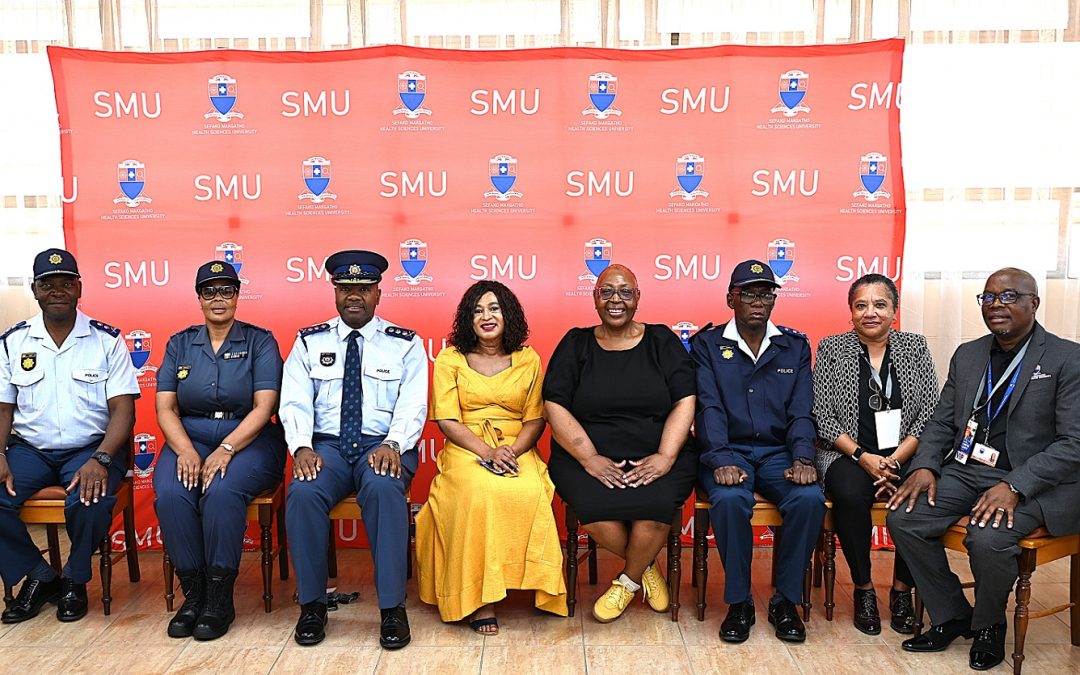
by Lorato | Oct 2, 2025 | Accolades and Achievements, All News, Alumni, SMU Media, Student Media
Sefako Makgatho Health Sciences University (SMU) has taken a decisive step in tackling campus insecurity and gender-based violence (GBV) with the launch of the Campus Community Safety Forum (CCSF). The two-day Safety Engagement, held on 1–2 October 2025 in partnership with the South African Police Service (SAPS), the Department of Higher Education and Training (DHET), civil society organisations and health providers, sent a clear message: safety and dignity on campus are non-negotiable.
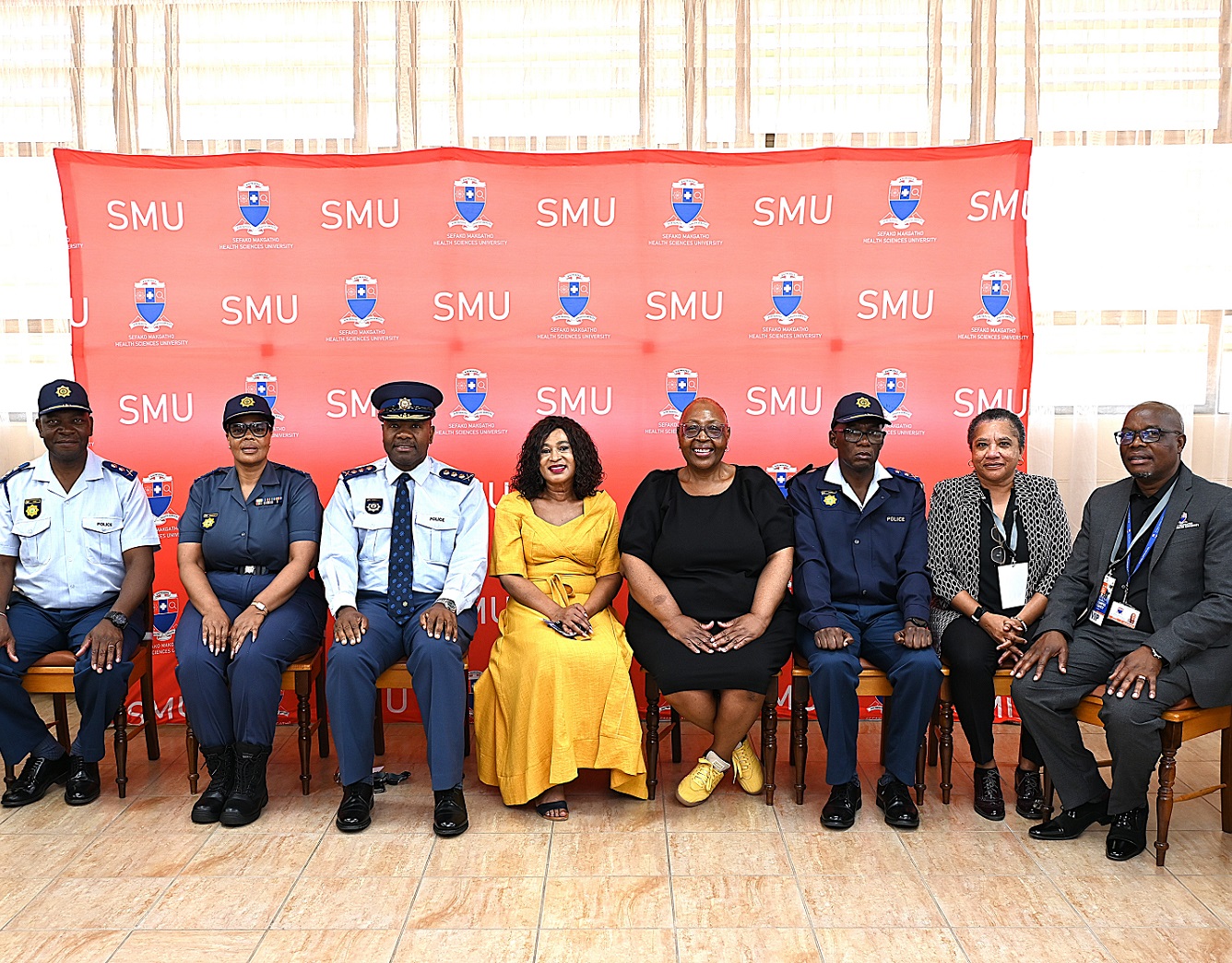 The programme was both urgent and collaborative. Day One centred on campus safety discussions, while Day Two marked the official establishment of the CCSF. Senior SAPS officials, university leadership, government representatives and students joined forces to strengthen coordinated action against GBV and crime.
The programme was both urgent and collaborative. Day One centred on campus safety discussions, while Day Two marked the official establishment of the CCSF. Senior SAPS officials, university leadership, government representatives and students joined forces to strengthen coordinated action against GBV and crime.
Key highlights included:
- A framework for campus safety and security
- Focus sessions on GBV, law and justice
- Survivor-centred dialogues on support and safe reporting
- Direct engagements with SAPS and DHET
- Drafting of the CCSF’s terms of reference
The CCSF was conceived not as a symbolic structure, but as a practical platform to identify risks, address security concerns and build confidence in campus protection systems – with students placed firmly at the centre of decision-making.
Day Two began with opening remarks from SMU’s Acting Deputy Vice-Chancellor for Operations, Odette Ramsingh: “Our academic project is key to the vision and mission of SMU. We remain resolute in our drive towards academic excellence and leading healthcare solutions that will benefit our families, communities and South Africa. Therefore, safety is a core enabler of teaching, research and student success. We cannot pursue excellence in a culture of harassment, fear and intimidation, and most especially not in violence.”
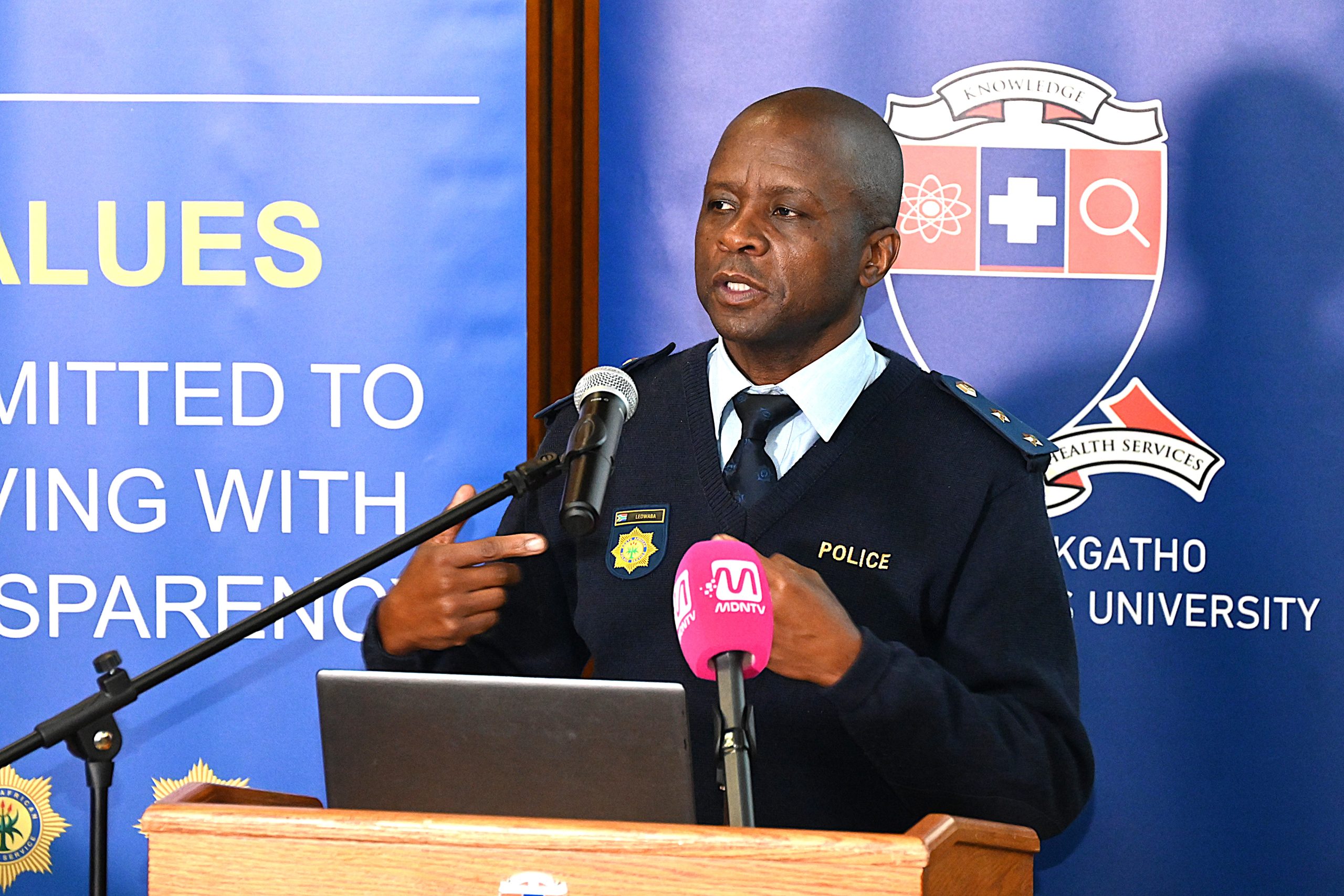 This was followed by an address from Vice-Chancellor, Professor Tandi Matsha-Erasmus, who stated: “This gathering is not ceremonial; it is a declaration. A declaration that SMU will remain unwavering in its resolve to create a campus where safety is not a privilege, but a promise. Let this forum not end with speeches, but with sustained action. Every theft prevented, every assault reported, every survivor supported is a victory for the values we hold dear.”
This was followed by an address from Vice-Chancellor, Professor Tandi Matsha-Erasmus, who stated: “This gathering is not ceremonial; it is a declaration. A declaration that SMU will remain unwavering in its resolve to create a campus where safety is not a privilege, but a promise. Let this forum not end with speeches, but with sustained action. Every theft prevented, every assault reported, every survivor supported is a victory for the values we hold dear.”
Messages of support from DHET, the Community Policing Forum, the Student Representatives and youth crime prevention structures reinforced a united front against GBV. The defining moment came when SAPS leaders joined SMU officials in signing the CCSF pledge, formally affirming their collective commitment. Gauteng Provincial Commissioner of Police, Lieutenant General Tommy Mthombeni, underscored the role of community forums and technology in addressing campus crime, highlighting the use of surveillance systems and the Gauteng e-panic button app.
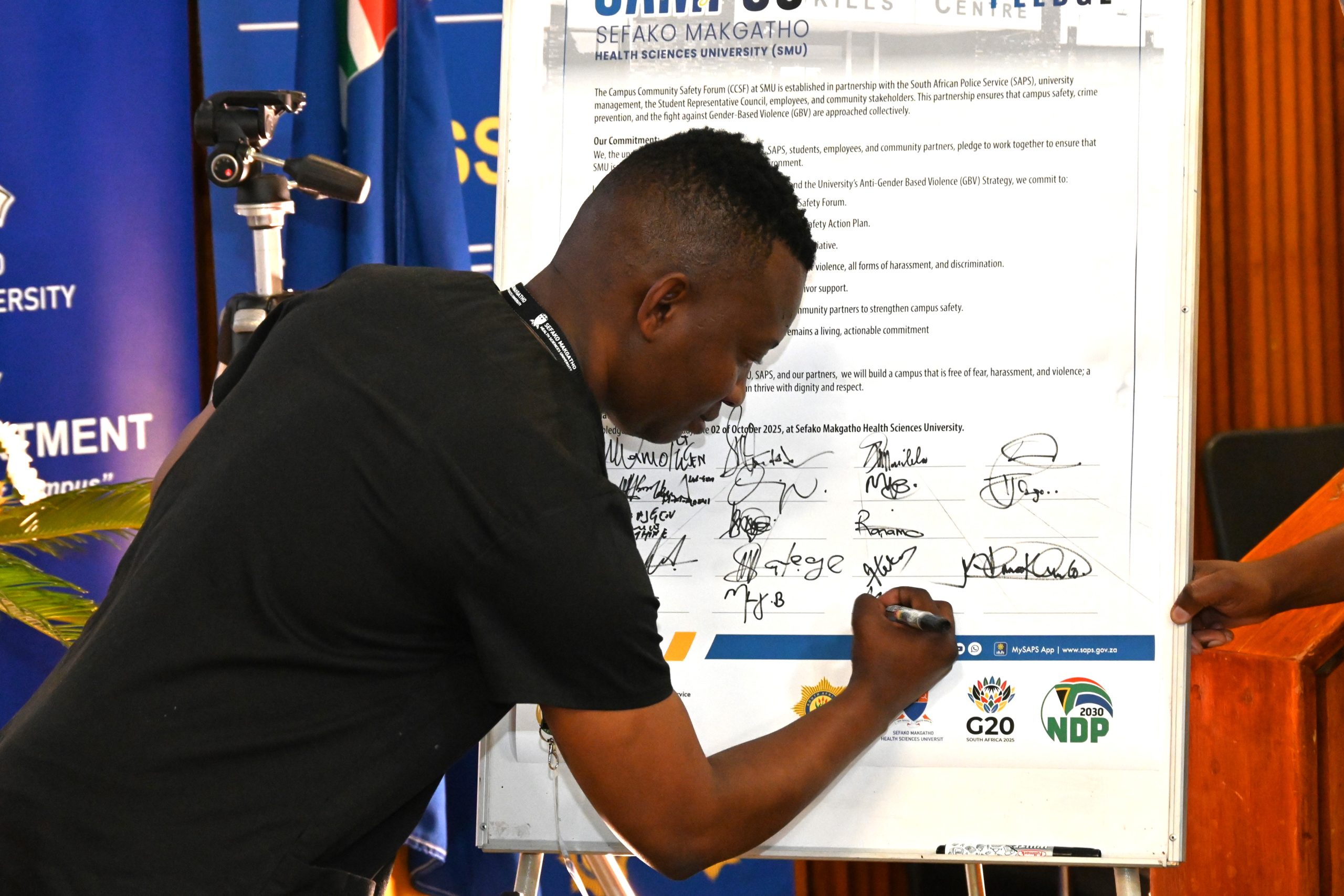 Student leadership also emphasised the urgency of the initiative. Outgoing SRC President, Katlego Moshanyane, reflected: “I am honoured to have participated in this launch, which prioritises student well-being and focuses sharply on eradicating GBV. This ensures SMU remains a safe environment for both students and staff.”
Student leadership also emphasised the urgency of the initiative. Outgoing SRC President, Katlego Moshanyane, reflected: “I am honoured to have participated in this launch, which prioritises student well-being and focuses sharply on eradicating GBV. This ensures SMU remains a safe environment for both students and staff.”
Organised labour endorsed the initiative with equal conviction. Dr Tshifhiwa Mulaudzi stated: “This vital initiative unites SAPS, staff and community leaders from Ga-Rankuwa to enhance campus security. Let us all participate fully to build a safer campus for everyone.”
At a time when South African universities face escalating security challenges, SMU has positioned itself as a leader in proactive, community-driven safety interventions. By combining law enforcement expertise, academic leadership, student voices and survivor support services, the CCSF is set to deliver lasting impact.
The campaign’s theme – “Safe Campus, Strong Voices – Together We Stop GBV” – captured the urgency and determination behind the initiative. Far from symbolic, the CCSF launch was a rallying call for sustained action, accountability, and a culture of safety built on shared responsibility.
By Tumelo Moila
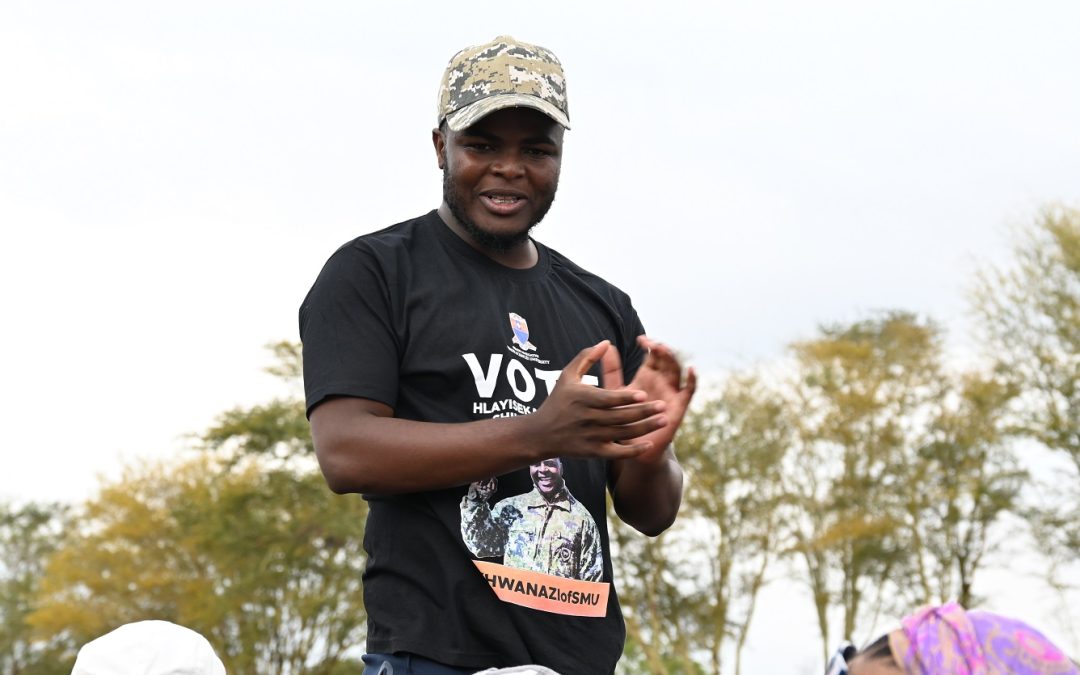
by Lorato | Oct 2, 2025 | All News, Alumni, SMU Media, Student Media
The air inside the University Sports Complex at Sefako Makgatho Health Sciences University (SMU) was charged with anticipation as administrative and support staff converged for a landmark occasion. Far from a routine gathering, the assembly marked a pivotal moment in the University’s governance story—the election of their voice to the SMU Council, the highest decision-making body entrusted with shaping the institution’s future.
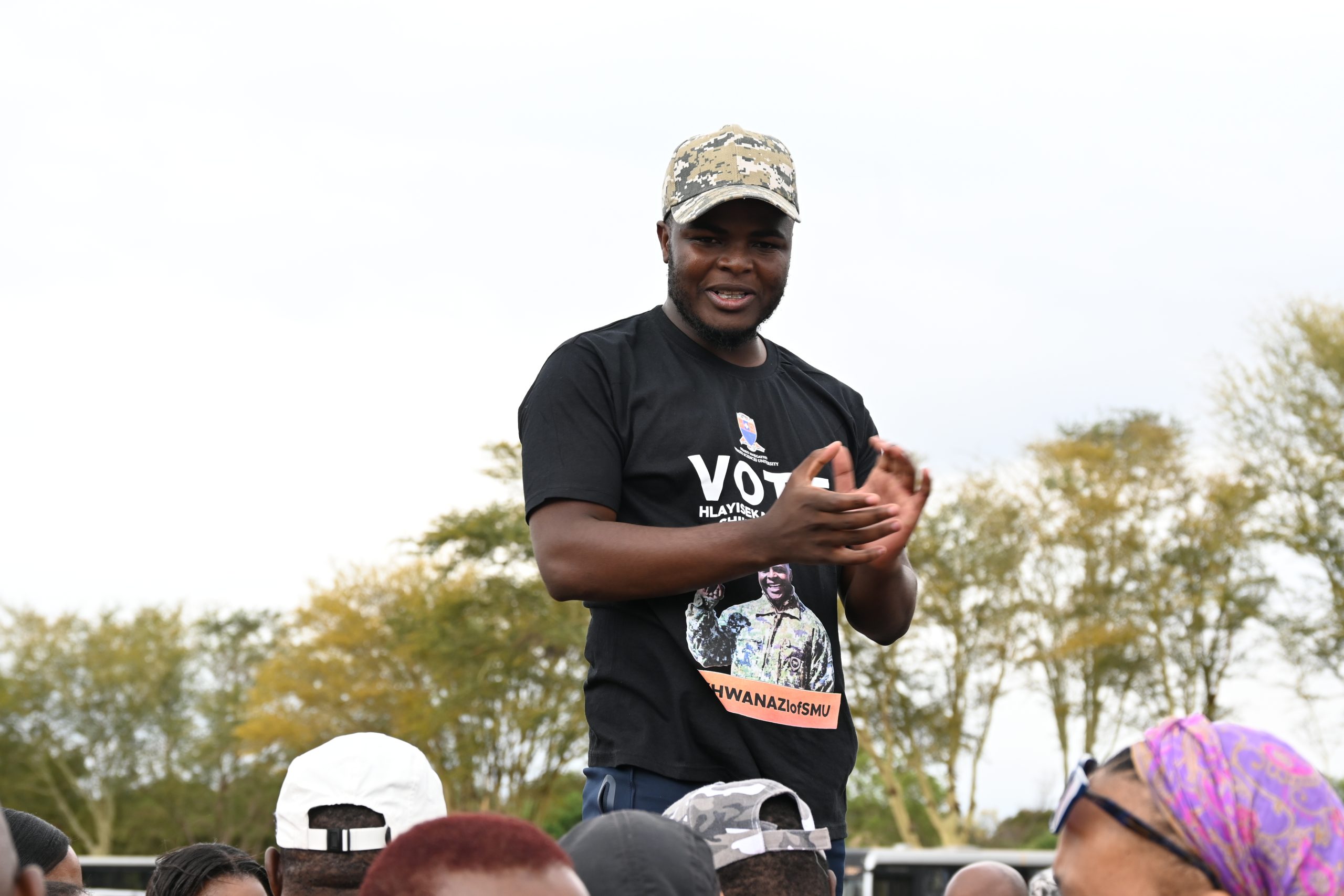 Interim Registrar, Mr Sello Simon Mokoena, who had taken office only weeks earlier, set the tone as he opened the proceedings. His words carried both weight and warmth. “The strength of SMU lies in the collective efforts of all its people,” he told the packed hall. “This election reflects our commitment to inclusive governance and to ensuring that every sector of our community has a voice at the highest decision-making level.”
Interim Registrar, Mr Sello Simon Mokoena, who had taken office only weeks earlier, set the tone as he opened the proceedings. His words carried both weight and warmth. “The strength of SMU lies in the collective efforts of all its people,” he told the packed hall. “This election reflects our commitment to inclusive governance and to ensuring that every sector of our community has a voice at the highest decision-making level.”
Two candidates stood before their colleagues: Hlayiseka Mukhari Shikwambana, a Laboratory Assistant in the Department of Biochemistry and Biotechnology, and Dr Tshifhiwa Mulaudzi, Deputy Director for Assets and Stores. Both were seasoned professionals with deep ties to the institution, and both were eager to carry the hopes of their peers into Council chambers.
The election unfolded through a secret ballot, tightly overseen by governance and audit structures to ensure fairness. Silence filled the hall as votes were counted and verified. Then came the announcement: Shikwambana had secured 268 votes to Mulaudzi’s 204. With a clear margin, he was declared the new Administrative and Support Staff Representative to the SMU Council.
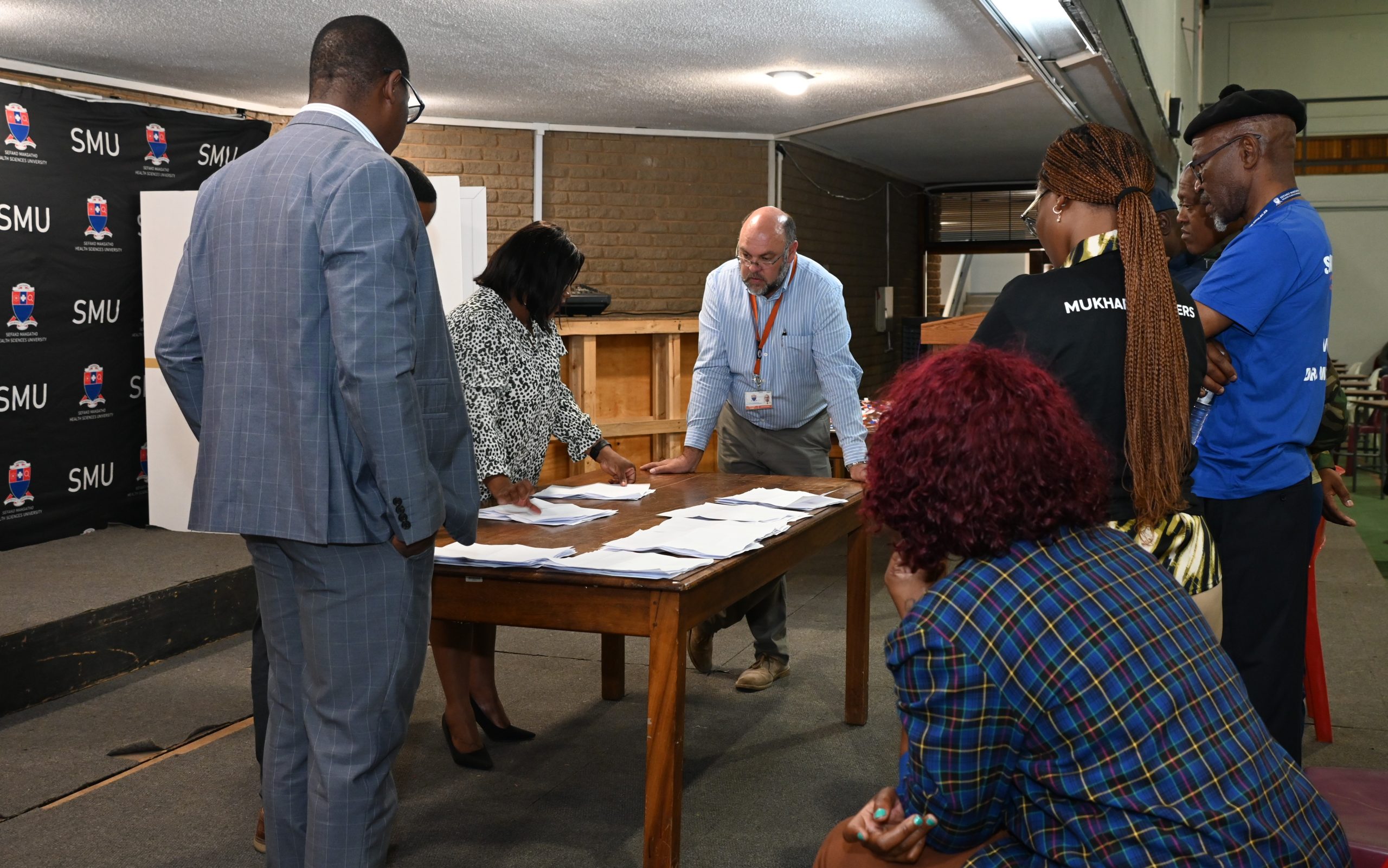 The moment was met with applause, but it was Shikwambana’s response that left a lasting impression. Taking the podium, he spoke with humility and conviction. “Your support is both humbling and empowering,” he began. “I pledge to represent all workers without fear or favour. Your struggles, challenges, and aspirations are my own.”
The moment was met with applause, but it was Shikwambana’s response that left a lasting impression. Taking the podium, he spoke with humility and conviction. “Your support is both humbling and empowering,” he began. “I pledge to represent all workers without fear or favour. Your struggles, challenges, and aspirations are my own.”
He described administrative and support staff as the “lifeblood of the institution,” emphasising their essential role in sustaining SMU’s academic mission. His words resonated with colleagues who have long sought recognition for their often-unseen contributions.
Shikwambana’s connection to SMU is more than professional—it is personal. Originally from Giyani and raised in Julesburg, Rhulani, Tzaneen, he has spent over a decade at the University as both a student and staff member. He holds three SMU degrees and is currently pursuing a PhD in Biochemistry, researching molecular biology and diabetes management. Alongside his administrative duties, he contributes academically by assisting with lectures and supervising postgraduate students.
This blend of scholarship and service shapes his vision for Council. He spoke of strengthening accountability within governance structures, creating promotion and reward systems to motivate staff, and ensuring that the voices of administrative and support employees are heard in every decision.
“Together, we will make SMU not only a place of academic excellence, but also a university of first choice for employees, students, and partners alike,” he declared. “With unity, transparency, and commitment, we can build a future where every staff member feels respected, valued, and proud to serve.”
The election marked more than a leadership choice—it was a reaffirmation of SMU’s commitment to participatory governance. By securing representation for administrative and support staff, the University continues to strengthen its culture of inclusivity and shared responsibility.
As the meeting drew to a close, the atmosphere was buoyant. Staff praised the transparency of the process and voiced optimism that Shikwambana’s leadership would amplify their interests at the Council table. For many, it was not just a win for a candidate but a win for every worker whose efforts fuel the University’s mission.
By Dimakatso Modise
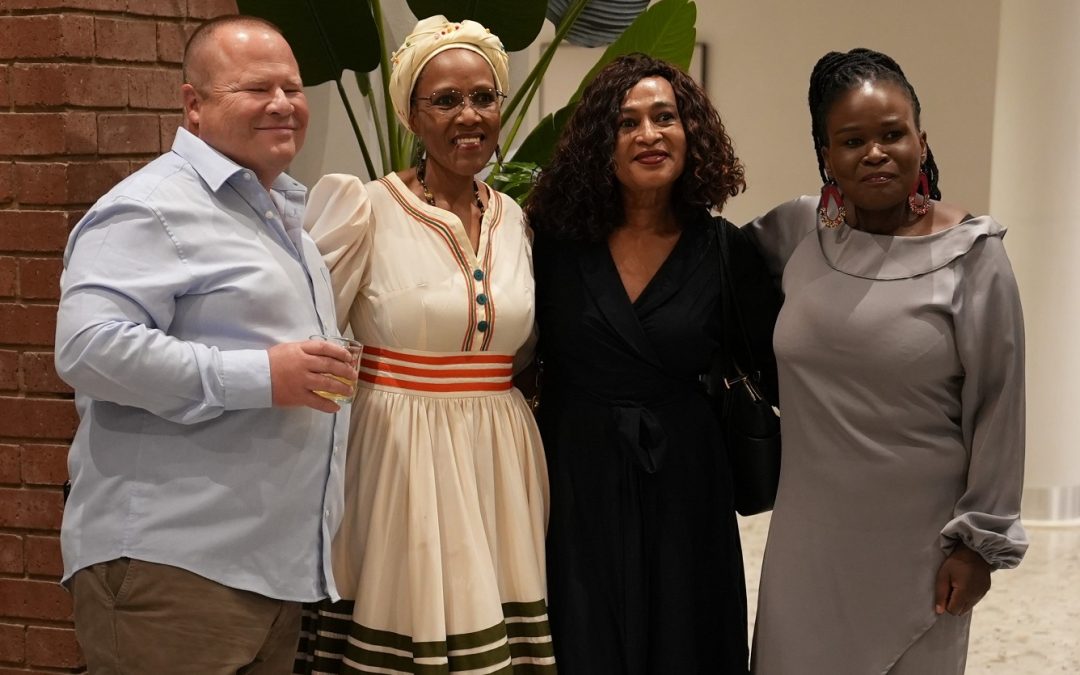
by Lorato | Oct 2, 2025 | All News, SMU Media, Student Media
Under the elegant glow of the ANEW Hotel in Centurion, Sefako Makgatho Health Sciences University (SMU) bid farewell to its outgoing Council members with an evening filled with gratitude, reflection, and celebration. More than a formal occasion, the dinner became a moving recognition of leaders whose vision and dedication have left an indelible mark on the university’s governance.
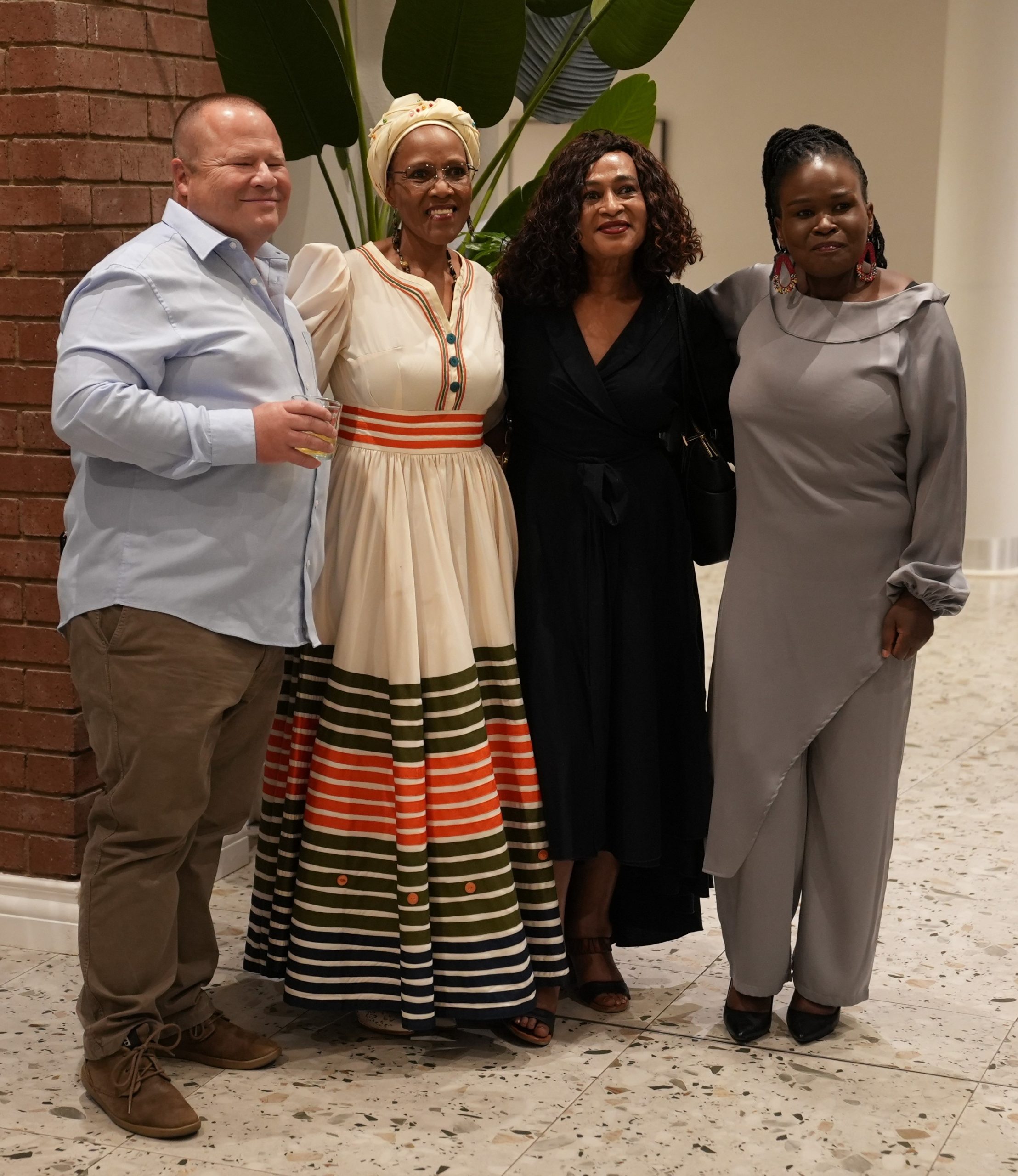 The evening opened with a warm welcome from Vice-Chancellor Professor Tandi Matsha-Erasmus. Her words set the tone for the night, reminding guests of the depth of the occasion. “Tonight, we celebrate not just the achievements of our Council members, but the wisdom and commitment they have shown in steering SMU to greater heights,” she said, drawing applause from the audience.
The evening opened with a warm welcome from Vice-Chancellor Professor Tandi Matsha-Erasmus. Her words set the tone for the night, reminding guests of the depth of the occasion. “Tonight, we celebrate not just the achievements of our Council members, but the wisdom and commitment they have shown in steering SMU to greater heights,” she said, drawing applause from the audience.
Council Chairperson Nontlaza Sizani followed with a heartfelt tribute, emphasising the weight of the members’ service. “Your contribution has strengthened SMU in ways that cannot be overstated. Each of you has left a mark on this institution—ensuring governance, strategy, and representation remain robust and impactful,” Sizani remarked.
The evening then shifted to moments of personal recognition. Each outgoing Council member’s contribution was honoured in turn, highlighting both individual strengths and the collective spirit of teamwork that defined their tenure.
- Dr Mangaliso Mahlaba was praised for his steady guidance and clarity in navigating complex decisions.
- Dr Johannes Tshifularo received acknowledgement for his work in academic oversight and tackling absenteeism, demonstrating his relentless commitment to improvement.
- Dr Johan van Heerden reflected on his contributions to human resources processes and committee work. His colleagues commended his insistence on accountability and efficiency, values that strengthened Council governance.
- Gladys Tlou Malema was celebrated for her advocacy on behalf of administrative and support staff, ensuring that their voices were consistently heard in shaping inclusive decisions.
These reflections painted a vivid picture of leadership grounded in service, responsibility, and collaboration. As the evening drew to a close, Deputy Chairperson of Council Nkosenhle Ngongoma offered an inspiring charge to the remaining members. “As we carry SMU forward, remember that unity, shared vision, and dedication are our greatest strengths. Together, we can take this university to new heights,” he urged, leaving the room with a sense of renewed purpose.
Beyond the formalities, the night was coloured by laughter, shared memories, and heartfelt conversations. Fine dining accompanied by a warm spirit of appreciation created an atmosphere of camaraderie, underscoring the respect and pride felt for those stepping down.
More than a farewell, the event reaffirmed SMU’s values—excellence, collaboration, and leadership rooted in service. It reminded all present that governance is not merely about policies and strategies, but about people, representation, and the relationships that sustain progress.
As SMU prepares for a new chapter, the legacy of these outgoing Council members remains deeply woven into its foundation. Their service will continue to inspire students, staff, and future leaders, anchoring the university’s path of growth and transformation.
By Dimakatso Modise
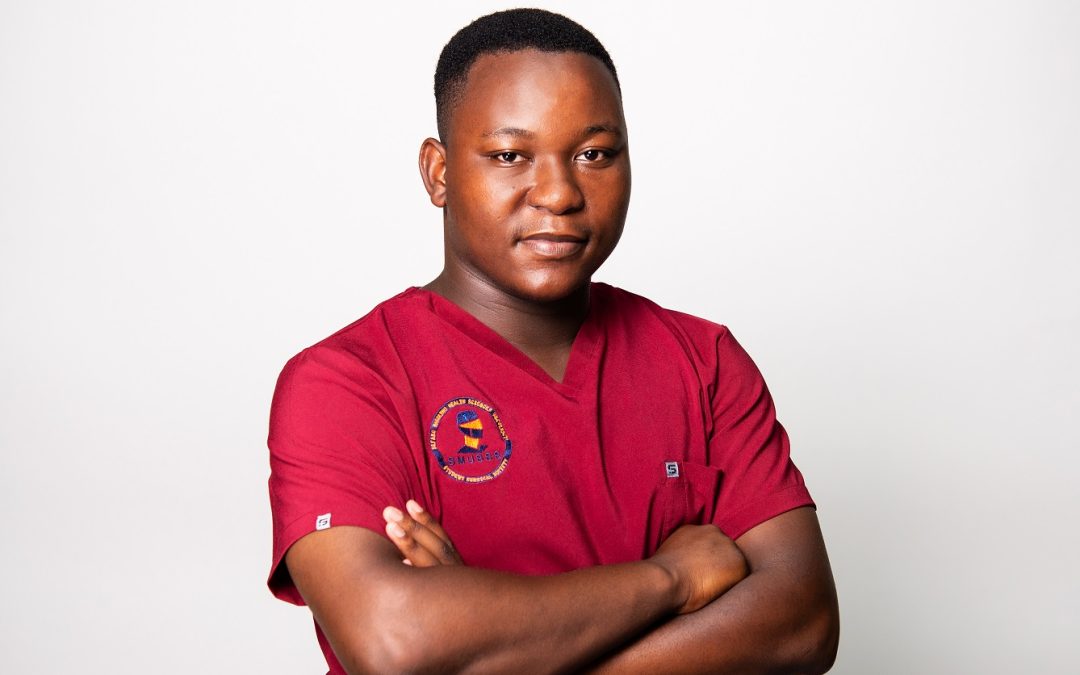
by Lorato | Oct 2, 2025 | All News, SMU Media, Student Media
At 22, Albert Sebulela’s journey reads like a story of resilience shaped by faith, discipline, and an unrelenting belief in education. Born in Manoke, a small village in Burgersfort, Limpopo, Sebulela grew up where opportunity was scarce and ambition often faded into survival. Many of his peers, he recalls, ended up unemployed or working informally after matric. But Sebulela chose another path. Raised by his grandmother in a Christian household while his parents worked away from home, he found early strength in her prayers and in the guidance of his teachers. Together with close friends, he spent long hours in study groups and Saturday classes, determined to prove that a boy from Manoke could become the first doctor in his family.
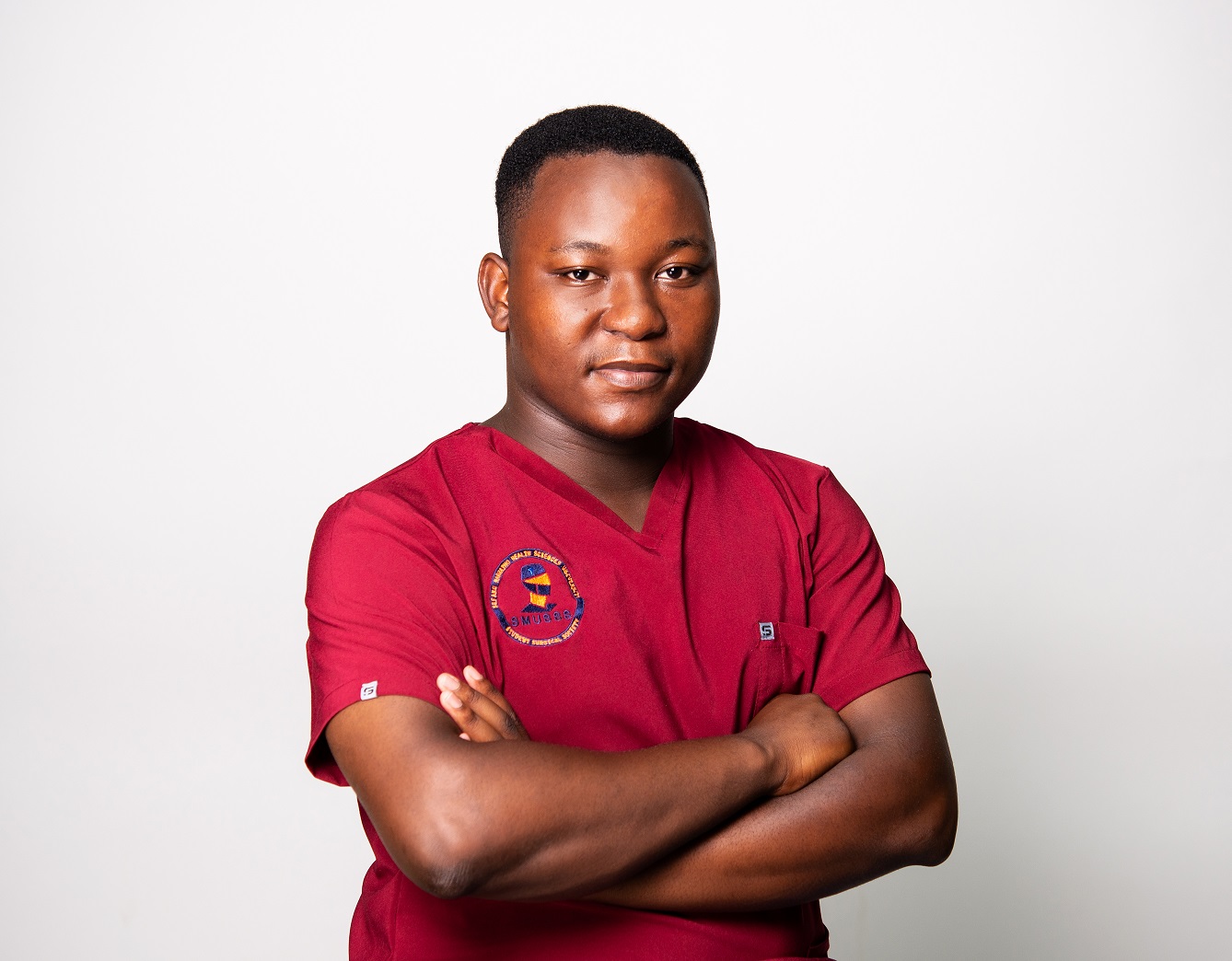 When he arrived at Sefako Makgatho Health Sciences University in 2022, it was to begin the MBChB Extended Programme. The seven-year journey ahead was daunting, but he accepted the challenge with clarity of purpose. “I reminded myself why I was here,” he says. “To serve my community and to show others that education is a way out.”
When he arrived at Sefako Makgatho Health Sciences University in 2022, it was to begin the MBChB Extended Programme. The seven-year journey ahead was daunting, but he accepted the challenge with clarity of purpose. “I reminded myself why I was here,” he says. “To serve my community and to show others that education is a way out.”
That clarity fuelled him through his studies and into student leadership. In 2024, he entered the SMUSSS Literature Review Competition with a paper on diabetic foot sepsis—a subject that carried personal weight, as his father suffers from diabetes. What began as a learning exercise turned into victory, with Albert taking first place. More than the award, it was the discovery of research as a tool to break cycles of disease that marked a turning point. Today, as Research and Academic Officer of SMUSSS, he works to create opportunities for undergraduates to contribute to research, convinced that inquiry must become a defining feature of SMU’s medical training.
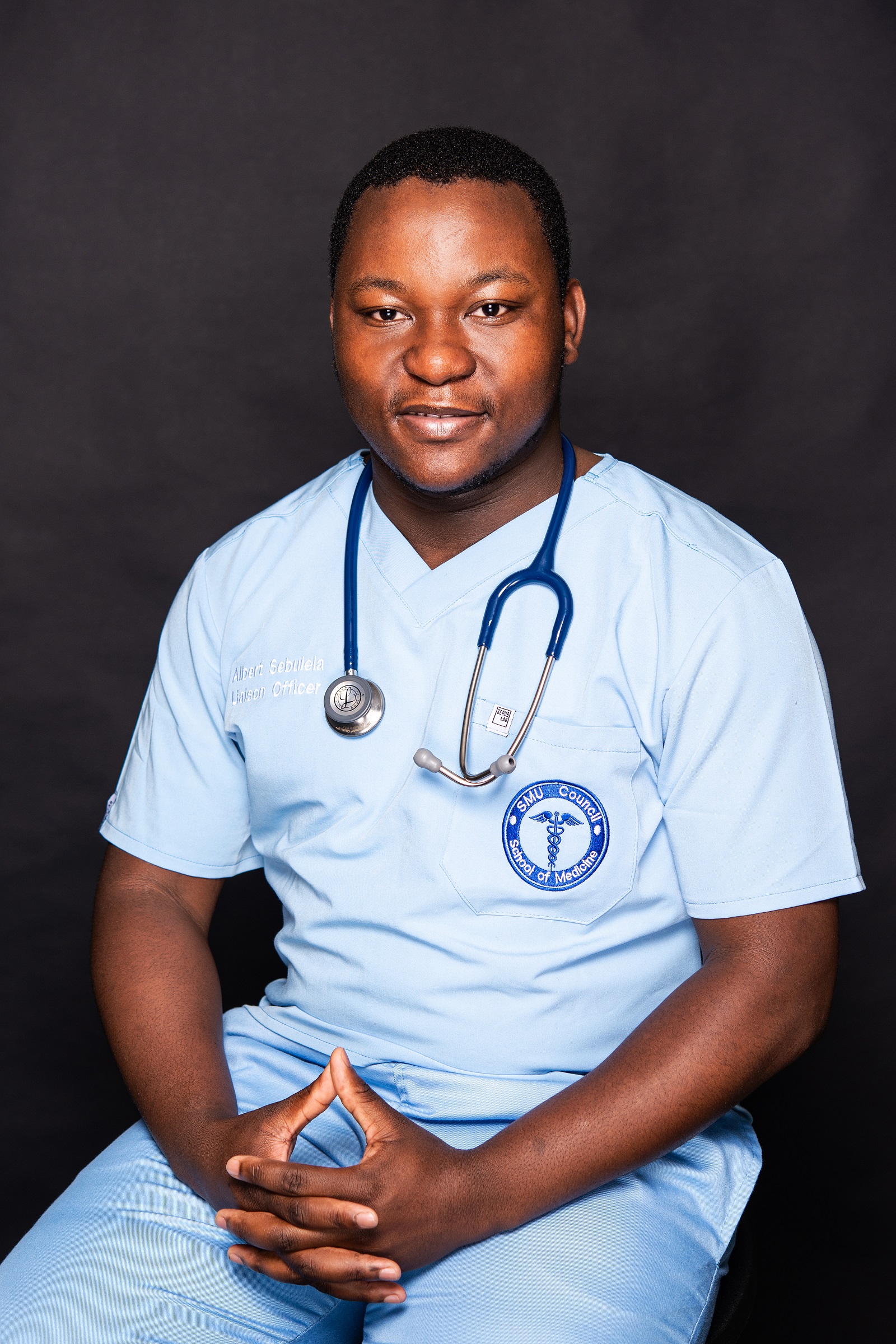 Alongside his academic achievements, Sebulela has become a fixture in student leadership. His list of roles is long: Deputy Secretary of the Diagnostic Society, Treasurer of the South African Medical Students’ Union (SMU branch), Manager of the SMU Rugby Male Team, Chairperson of Residence 5B, and Secondary Liaison Officer for the School of Medicine. He also served as a CUTL mentor and Vice Secretary of the Green Campus Initiative. To outsiders, the workload might appear overwhelming, but Sebulela insists that discipline and prayer keep him steady. “My degree is my priority, but leadership builds the character to sustain it,” he explains.
Alongside his academic achievements, Sebulela has become a fixture in student leadership. His list of roles is long: Deputy Secretary of the Diagnostic Society, Treasurer of the South African Medical Students’ Union (SMU branch), Manager of the SMU Rugby Male Team, Chairperson of Residence 5B, and Secondary Liaison Officer for the School of Medicine. He also served as a CUTL mentor and Vice Secretary of the Green Campus Initiative. To outsiders, the workload might appear overwhelming, but Sebulela insists that discipline and prayer keep him steady. “My degree is my priority, but leadership builds the character to sustain it,” he explains.
Every step of his journey is anchored by family values. His father’s constant reminder—serve selflessly and do good even when no one is watching—guides how he approaches service, while his grandmother’s prayers, he says, are the foundation of his resilience. Faith remains his compass, with verses such as Jeremiah 1:5 and Joshua 1:8–9 shaping his confidence and resolve.
Looking to the future, Sebulela dreams of becoming a cardiothoracic surgeon. Inspired by figures like Professor Risenga Chauke, Dean of the SMU School of Medicine, he hopes to leave the kind of impact that his mentors have had on both patients and students.
For young people from under-resourced backgrounds, his message is unwavering: believe in yourself, create opportunities where none exist, and serve others selflessly. His story, still in its early chapters, is proof that resilience and vision can transform adversity into triumph.
By Tumelo Moila
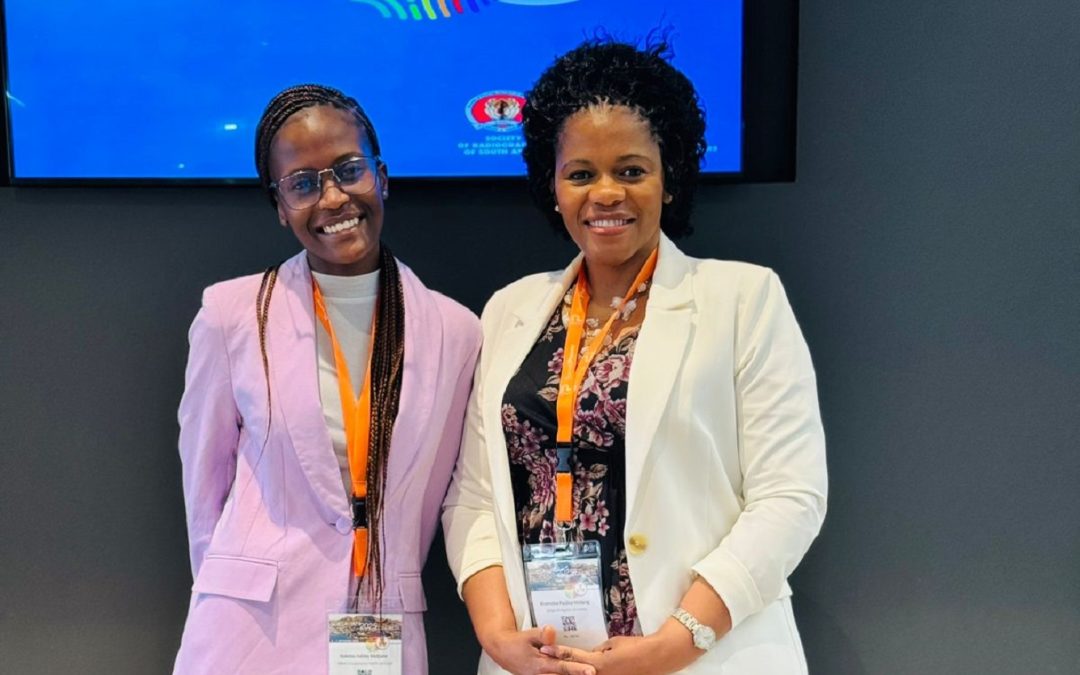
by Lorato | Oct 2, 2025 | Accolades and Achievements, All News, SMU Media, Student Media
Koketso Ashley Matjiane, a post-community service Radiographer and recent SMU graduate, is making waves in occupational health through her pioneering research on coal mine dust lung diseases (CMDLD). Recently, she presented her findings at the SORSA-IAFR Congress, a prestigious international platform, highlighting the role Radiographers play in diagnosing lung diseases in miners.
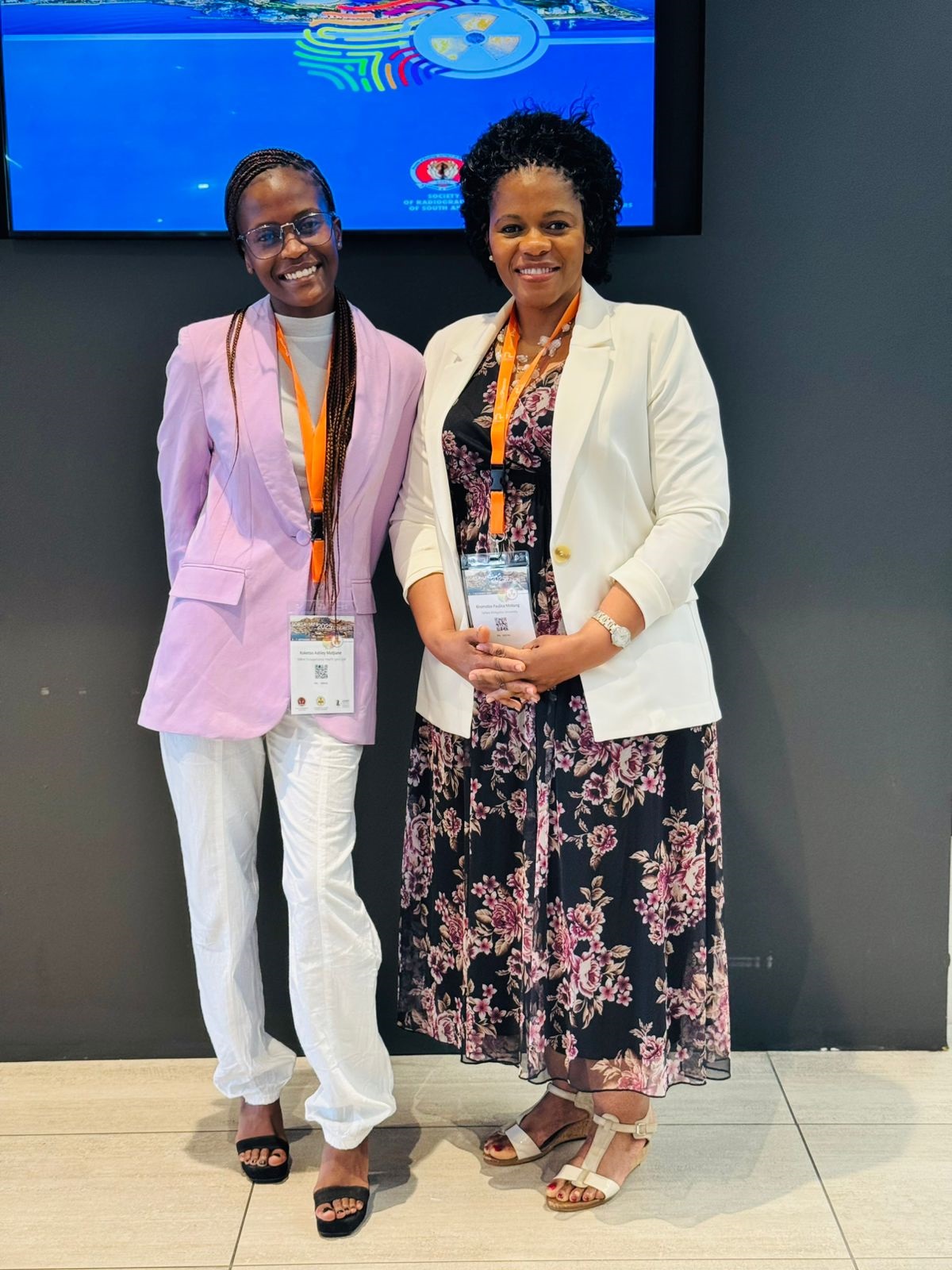 “I’ve always been passionate about evidence-based practice,” Koketso says, reflecting on the journey that led her from classroom inspiration to international recognition. “My lecturer, Mrs Khomotso Motiang, encouraged me to pursue research beyond my final-year studies. With her guidance, I submitted an abstract and found myself presenting to an audience of global professionals.”
“I’ve always been passionate about evidence-based practice,” Koketso says, reflecting on the journey that led her from classroom inspiration to international recognition. “My lecturer, Mrs Khomotso Motiang, encouraged me to pursue research beyond my final-year studies. With her guidance, I submitted an abstract and found myself presenting to an audience of global professionals.”
Her research focused on radiographic pattern recognition of common CMDLD cases she encountered during her first three months as a post-community service Radiographer. Working as the sole Radiographer at her facility, without an on-site Radiologist, she was compelled to interpret radiographs independently. “I had to make sure no abnormalities were missed,” she recalls. “It was challenging, but it sharpened my skills and reinforced the importance of early detection of coal mine lung diseases.”
At the congress, Koketso shared not only her findings but also her insights into the broader implications for occupational health. She emphasised that Radiographers in resource-constrained settings are often the first line of defence for miners’ health. “Every scan we analyse can directly impact a worker’s life,” she explains. Her research demonstrates that accurate, timely radiographic interpretation can dramatically improve early CMDLD diagnosis and strengthen occupational health services.
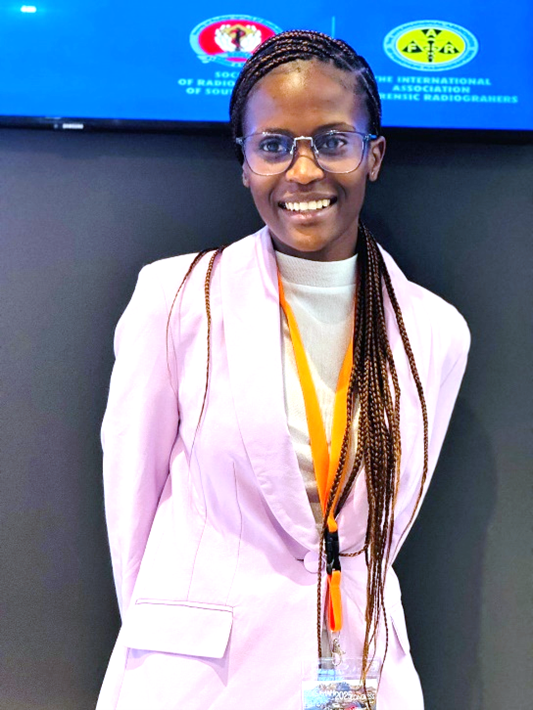 Beyond the scientific presentations, the congress offered opportunities to forge collaborations. “I met professionals who are equally committed to improving miners’ health,” Koketso says. “It inspired me to think about joint projects that could make a real difference in high-risk communities.”
Beyond the scientific presentations, the congress offered opportunities to forge collaborations. “I met professionals who are equally committed to improving miners’ health,” Koketso says. “It inspired me to think about joint projects that could make a real difference in high-risk communities.”
Reflecting on her journey, she stresses the importance of mentorship and early professional growth. “Mrs Motiang’s guidance was pivotal. Her encouragement pushed me to take on research at the start of my career, and that momentum continues to drive me forward.”
Looking ahead, Koketso plans to further her studies in 2026, aiming to play a decisive role in shaping equitable, effective healthcare for vulnerable workers. “Evidence-based research isn’t just academic—it’s a tool to improve lives,” she says. “I want to ensure miners get the care they need and that occupational health services are strengthened across South Africa.”
From student to internationally recognised researcher, Koketso’s story is a testament to perseverance, mentorship, and the power of applying knowledge where it matters most.
By Tumelo Moila

 Her path began in Grade 7, when a teacher asked her class to write down their future ambitions and bury them for the future. At the time, Dr Shabalala was academically challenged, particularly in Mathematics, and often misunderstood. Yet, she boldly wrote that she would one day be a doctor. It was not a carefully considered choice, but rather a challenge to herself and to God. Years later, her father encouraged her towards dentistry — a decision that evolved from a profession into a calling. While still at university, she even declared to friends that she would one day become an orthodontist, a bold vision that later became reality.
Her path began in Grade 7, when a teacher asked her class to write down their future ambitions and bury them for the future. At the time, Dr Shabalala was academically challenged, particularly in Mathematics, and often misunderstood. Yet, she boldly wrote that she would one day be a doctor. It was not a carefully considered choice, but rather a challenge to herself and to God. Years later, her father encouraged her towards dentistry — a decision that evolved from a profession into a calling. While still at university, she even declared to friends that she would one day become an orthodontist, a bold vision that later became reality. As a supernumerary candidate, she often faced exclusion and bias, but she also encountered God given mentors who guided her through the challenges. Among them were Prof Robert Ndou, Prof Harold Majana, Dr Maurine Dikeledi Letsholo, Dr Solly Nkhumeleni and Prof Sonia Boy, whose support reinforced the importance of perseverance, integrity, and grace under pressure.
As a supernumerary candidate, she often faced exclusion and bias, but she also encountered God given mentors who guided her through the challenges. Among them were Prof Robert Ndou, Prof Harold Majana, Dr Maurine Dikeledi Letsholo, Dr Solly Nkhumeleni and Prof Sonia Boy, whose support reinforced the importance of perseverance, integrity, and grace under pressure.

 The study is being led by MAI Group, an international consulting and engineering firm, headquartered in Spain, in partnership with Erinite Energy, a South African renewable energy company. Together, they bring world-class expertise and local insight to one of SMU’s most ambitious infrastructure projects to date.
The study is being led by MAI Group, an international consulting and engineering firm, headquartered in Spain, in partnership with Erinite Energy, a South African renewable energy company. Together, they bring world-class expertise and local insight to one of SMU’s most ambitious infrastructure projects to date. The kick-off meeting was also attended by Ms Odette Ramsingh, Acting Deputy Vice-Chancellor: Operations, whose presence highlighted SMU’s high-level institutional commitment to the initiative. Her involvement ensures that the project is fully aligned with the University’s operational priorities, third stream income objectives and strategic sustainability goals.
The kick-off meeting was also attended by Ms Odette Ramsingh, Acting Deputy Vice-Chancellor: Operations, whose presence highlighted SMU’s high-level institutional commitment to the initiative. Her involvement ensures that the project is fully aligned with the University’s operational priorities, third stream income objectives and strategic sustainability goals.
 The campaign was chaired by Dietetics student Lebogang Alison Mathe, supported by a team comprising Thabelo Tshikhudo (Secretary), Noluthando Nsele (Media Officer), and treasurers Tebogo Mathiane and Risana Vusi Malebele. Together, they mobilised fellow students and university departments to create a vibrant, campus-wide culture of wellness.
The campaign was chaired by Dietetics student Lebogang Alison Mathe, supported by a team comprising Thabelo Tshikhudo (Secretary), Noluthando Nsele (Media Officer), and treasurers Tebogo Mathiane and Risana Vusi Malebele. Together, they mobilised fellow students and university departments to create a vibrant, campus-wide culture of wellness. The Department of Built Environment also contributed, emphasising the link between sustainability and health. “A cleaner and greener campus improves mental clarity, reduces stress and supports healthy lifestyles. Protecting our environment means protecting ourselves,” said Dietetics student and representative Amanda Mashabela.
The Department of Built Environment also contributed, emphasising the link between sustainability and health. “A cleaner and greener campus improves mental clarity, reduces stress and supports healthy lifestyles. Protecting our environment means protecting ourselves,” said Dietetics student and representative Amanda Mashabela.
 This was no ceremonial visit — it is a working partnership. Teams from SMU’s Departments of Biology and Environmental Sciences, Occupational Health and Safety, Academic Literacy, Library and Information Services, Physiotherapy, Built Environment (Horticulture), and the Interprofessional Education and Collaborative Practice (IPECP) Unit came together with one goal: to deliver practical, lasting impact.
This was no ceremonial visit — it is a working partnership. Teams from SMU’s Departments of Biology and Environmental Sciences, Occupational Health and Safety, Academic Literacy, Library and Information Services, Physiotherapy, Built Environment (Horticulture), and the Interprofessional Education and Collaborative Practice (IPECP) Unit came together with one goal: to deliver practical, lasting impact. Literacy was another key focus. The Library and Information Services team launched the school’s library with books donated through a successful book drive and newly purchased titles. Learners read aloud, took part in language activities, and shared stories with their peers. The Academic Literacy Unit reinforced the message with the Setswana proverb “Lekau le sa eteng, le nyala kgaitsadi-a-lona” — meaning he who never travels ends up marrying his cousin. “Reading takes you places you might never reach physically. It broadens horizons and inoculates the mind against ignorance,” said Mmakgoshi Reetseng, Senior Librarian and event liaison officer.
Literacy was another key focus. The Library and Information Services team launched the school’s library with books donated through a successful book drive and newly purchased titles. Learners read aloud, took part in language activities, and shared stories with their peers. The Academic Literacy Unit reinforced the message with the Setswana proverb “Lekau le sa eteng, le nyala kgaitsadi-a-lona” — meaning he who never travels ends up marrying his cousin. “Reading takes you places you might never reach physically. It broadens horizons and inoculates the mind against ignorance,” said Mmakgoshi Reetseng, Senior Librarian and event liaison officer.
 From the moment guests arrived, the energy was purposeful. The Green Welcome set the tone for an afternoon rooted in action and collaboration. Opening the programme, GCI Chairperson Atlegang Leeuw called for student-led accountability in sustainability efforts. “Sustainability starts with us,” she said. “As future health professionals, we have a duty to create a healthier environment for generations to come.”
From the moment guests arrived, the energy was purposeful. The Green Welcome set the tone for an afternoon rooted in action and collaboration. Opening the programme, GCI Chairperson Atlegang Leeuw called for student-led accountability in sustainability efforts. “Sustainability starts with us,” she said. “As future health professionals, we have a duty to create a healthier environment for generations to come.” To deepen engagement, the municipality invited students to complete a sustainability questionnaire, offering prizes that sparked discussion on local environmental issues and everyday action.
To deepen engagement, the municipality invited students to complete a sustainability questionnaire, offering prizes that sparked discussion on local environmental issues and everyday action.
 The programme was both urgent and collaborative. Day One centred on campus safety discussions, while Day Two marked the official establishment of the CCSF. Senior SAPS officials, university leadership, government representatives and students joined forces to strengthen coordinated action against GBV and crime.
The programme was both urgent and collaborative. Day One centred on campus safety discussions, while Day Two marked the official establishment of the CCSF. Senior SAPS officials, university leadership, government representatives and students joined forces to strengthen coordinated action against GBV and crime. This was followed by an address from Vice-Chancellor, Professor Tandi Matsha-Erasmus, who stated: “This gathering is not ceremonial; it is a declaration. A declaration that SMU will remain unwavering in its resolve to create a campus where safety is not a privilege, but a promise. Let this forum not end with speeches, but with sustained action. Every theft prevented, every assault reported, every survivor supported is a victory for the values we hold dear.”
This was followed by an address from Vice-Chancellor, Professor Tandi Matsha-Erasmus, who stated: “This gathering is not ceremonial; it is a declaration. A declaration that SMU will remain unwavering in its resolve to create a campus where safety is not a privilege, but a promise. Let this forum not end with speeches, but with sustained action. Every theft prevented, every assault reported, every survivor supported is a victory for the values we hold dear.” Student leadership also emphasised the urgency of the initiative. Outgoing SRC President, Katlego Moshanyane, reflected: “I am honoured to have participated in this launch, which prioritises student well-being and focuses sharply on eradicating GBV. This ensures SMU remains a safe environment for both students and staff.”
Student leadership also emphasised the urgency of the initiative. Outgoing SRC President, Katlego Moshanyane, reflected: “I am honoured to have participated in this launch, which prioritises student well-being and focuses sharply on eradicating GBV. This ensures SMU remains a safe environment for both students and staff.”
 Interim Registrar, Mr Sello Simon Mokoena, who had taken office only weeks earlier, set the tone as he opened the proceedings. His words carried both weight and warmth. “The strength of SMU lies in the collective efforts of all its people,” he told the packed hall. “This election reflects our commitment to inclusive governance and to ensuring that every sector of our community has a voice at the highest decision-making level.”
Interim Registrar, Mr Sello Simon Mokoena, who had taken office only weeks earlier, set the tone as he opened the proceedings. His words carried both weight and warmth. “The strength of SMU lies in the collective efforts of all its people,” he told the packed hall. “This election reflects our commitment to inclusive governance and to ensuring that every sector of our community has a voice at the highest decision-making level.” The moment was met with applause, but it was Shikwambana’s response that left a lasting impression. Taking the podium, he spoke with humility and conviction. “Your support is both humbling and empowering,” he began. “I pledge to represent all workers without fear or favour. Your struggles, challenges, and aspirations are my own.”
The moment was met with applause, but it was Shikwambana’s response that left a lasting impression. Taking the podium, he spoke with humility and conviction. “Your support is both humbling and empowering,” he began. “I pledge to represent all workers without fear or favour. Your struggles, challenges, and aspirations are my own.”
 The evening opened with a warm welcome from Vice-Chancellor Professor Tandi Matsha-Erasmus. Her words set the tone for the night, reminding guests of the depth of the occasion. “Tonight, we celebrate not just the achievements of our Council members, but the wisdom and commitment they have shown in steering SMU to greater heights,” she said, drawing applause from the audience.
The evening opened with a warm welcome from Vice-Chancellor Professor Tandi Matsha-Erasmus. Her words set the tone for the night, reminding guests of the depth of the occasion. “Tonight, we celebrate not just the achievements of our Council members, but the wisdom and commitment they have shown in steering SMU to greater heights,” she said, drawing applause from the audience.
 When he arrived at Sefako Makgatho Health Sciences University in 2022, it was to begin the MBChB Extended Programme. The seven-year journey ahead was daunting, but he accepted the challenge with clarity of purpose. “I reminded myself why I was here,” he says. “To serve my community and to show others that education is a way out.”
When he arrived at Sefako Makgatho Health Sciences University in 2022, it was to begin the MBChB Extended Programme. The seven-year journey ahead was daunting, but he accepted the challenge with clarity of purpose. “I reminded myself why I was here,” he says. “To serve my community and to show others that education is a way out.” Alongside his academic achievements, Sebulela has become a fixture in student leadership. His list of roles is long: Deputy Secretary of the Diagnostic Society, Treasurer of the South African Medical Students’ Union (SMU branch), Manager of the SMU Rugby Male Team, Chairperson of Residence 5B, and Secondary Liaison Officer for the School of Medicine. He also served as a CUTL mentor and Vice Secretary of the Green Campus Initiative. To outsiders, the workload might appear overwhelming, but Sebulela insists that discipline and prayer keep him steady. “My degree is my priority, but leadership builds the character to sustain it,” he explains.
Alongside his academic achievements, Sebulela has become a fixture in student leadership. His list of roles is long: Deputy Secretary of the Diagnostic Society, Treasurer of the South African Medical Students’ Union (SMU branch), Manager of the SMU Rugby Male Team, Chairperson of Residence 5B, and Secondary Liaison Officer for the School of Medicine. He also served as a CUTL mentor and Vice Secretary of the Green Campus Initiative. To outsiders, the workload might appear overwhelming, but Sebulela insists that discipline and prayer keep him steady. “My degree is my priority, but leadership builds the character to sustain it,” he explains.
 “I’ve always been passionate about evidence-based practice,” Koketso says, reflecting on the journey that led her from classroom inspiration to international recognition. “My lecturer, Mrs Khomotso Motiang, encouraged me to pursue research beyond my final-year studies. With her guidance, I submitted an abstract and found myself presenting to an audience of global professionals.”
“I’ve always been passionate about evidence-based practice,” Koketso says, reflecting on the journey that led her from classroom inspiration to international recognition. “My lecturer, Mrs Khomotso Motiang, encouraged me to pursue research beyond my final-year studies. With her guidance, I submitted an abstract and found myself presenting to an audience of global professionals.” Beyond the scientific presentations, the congress offered opportunities to forge collaborations. “I met professionals who are equally committed to improving miners’ health,” Koketso says. “It inspired me to think about joint projects that could make a real difference in high-risk communities.”
Beyond the scientific presentations, the congress offered opportunities to forge collaborations. “I met professionals who are equally committed to improving miners’ health,” Koketso says. “It inspired me to think about joint projects that could make a real difference in high-risk communities.”